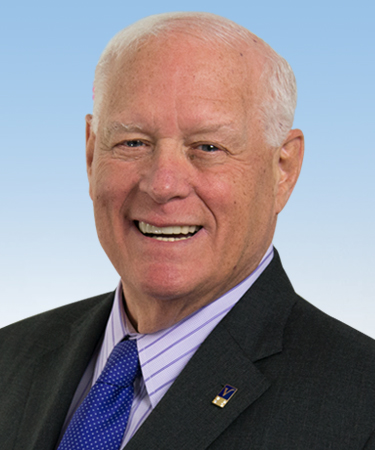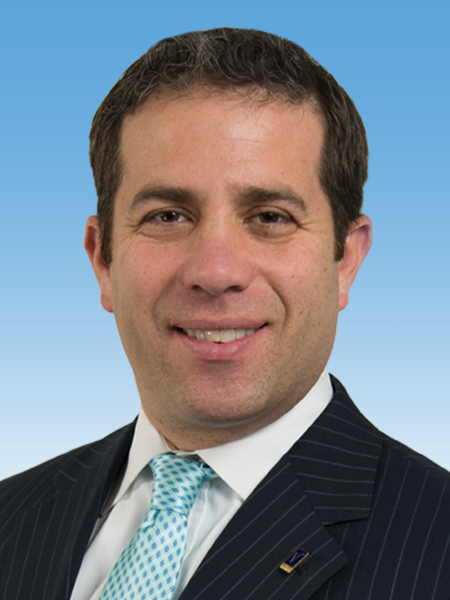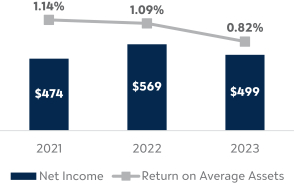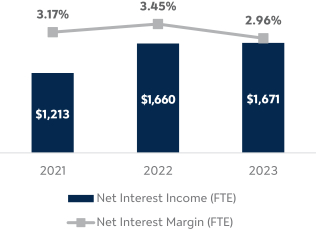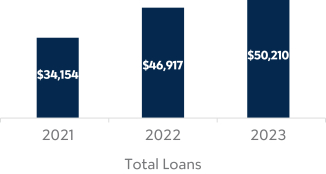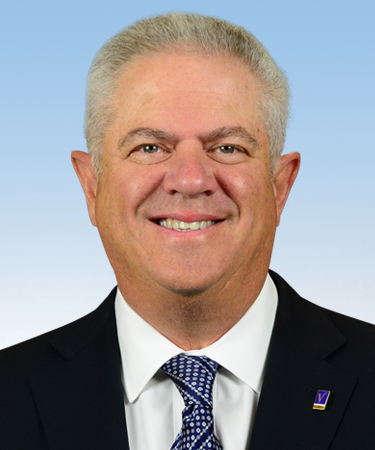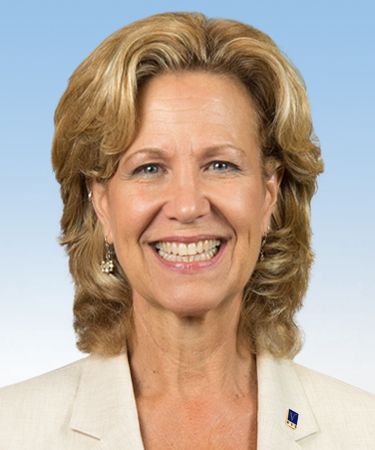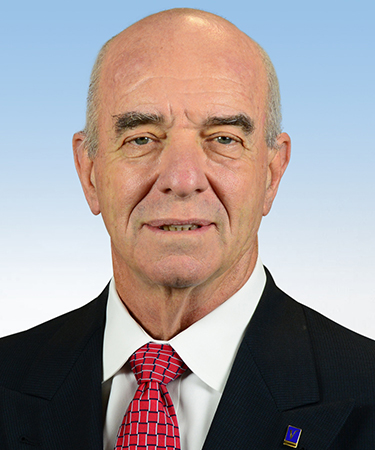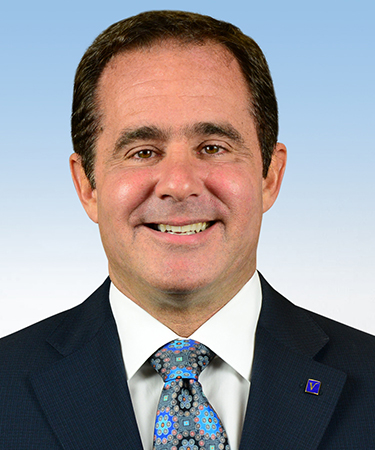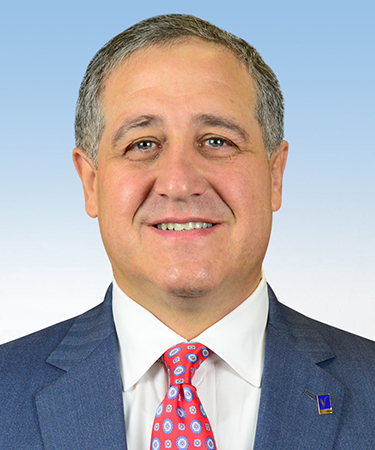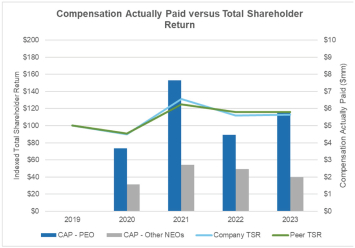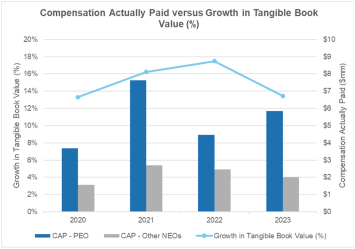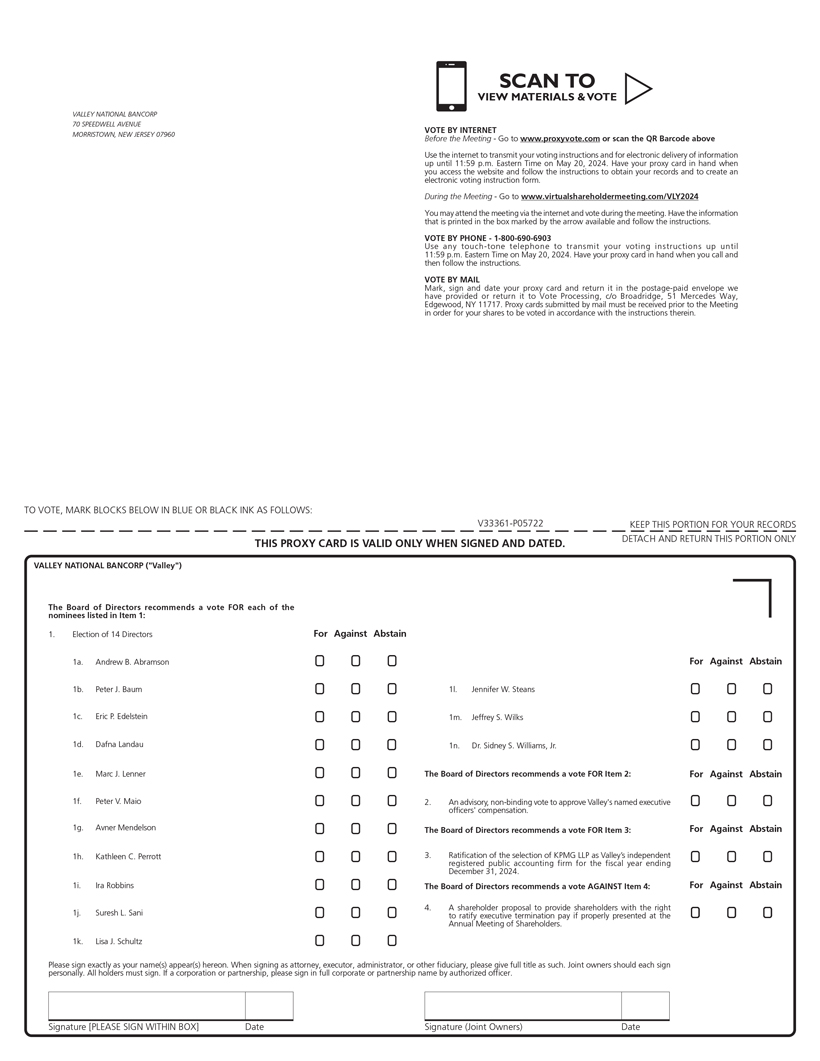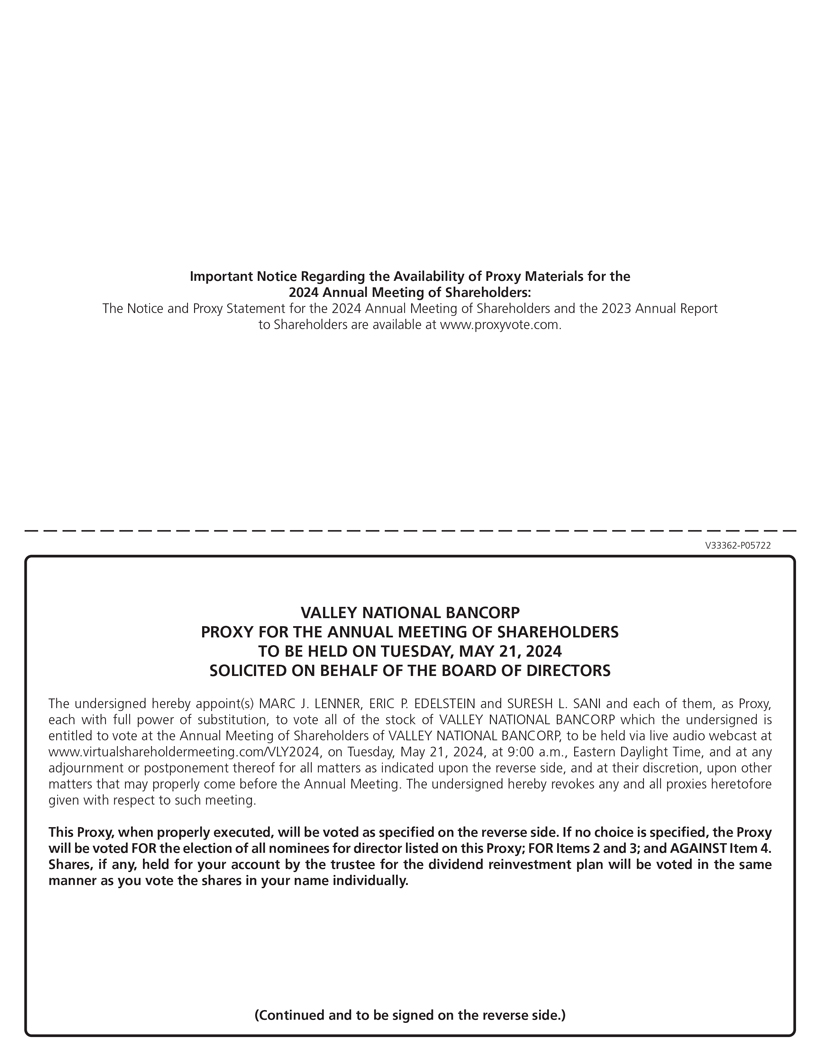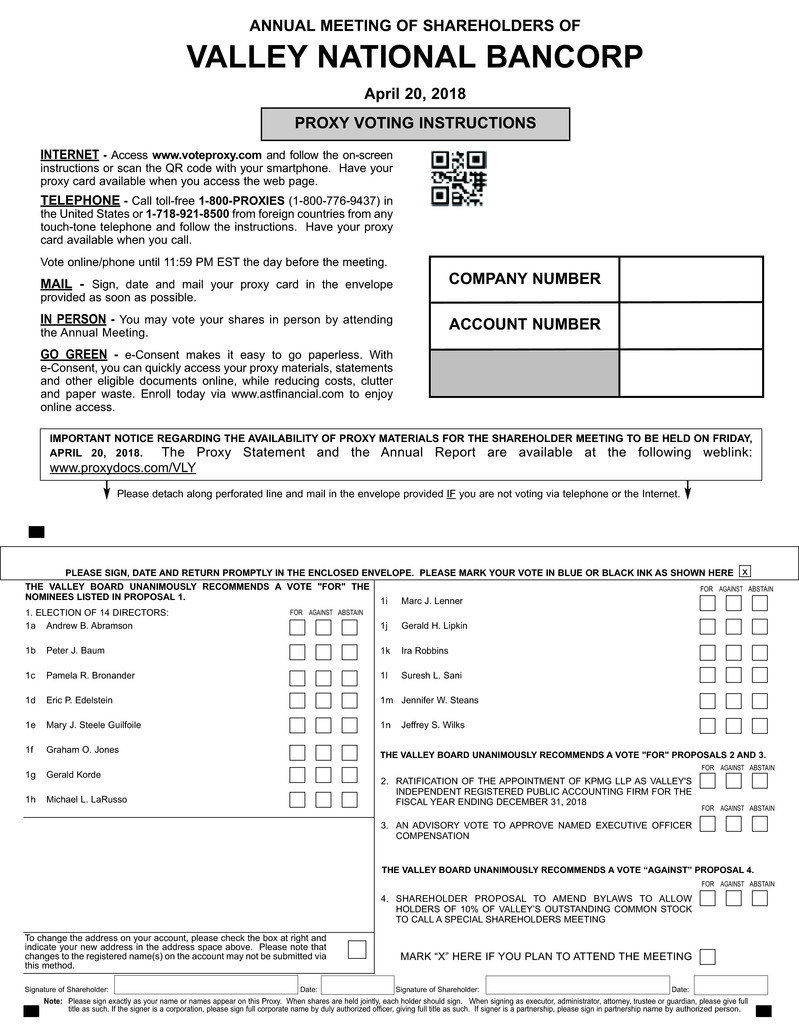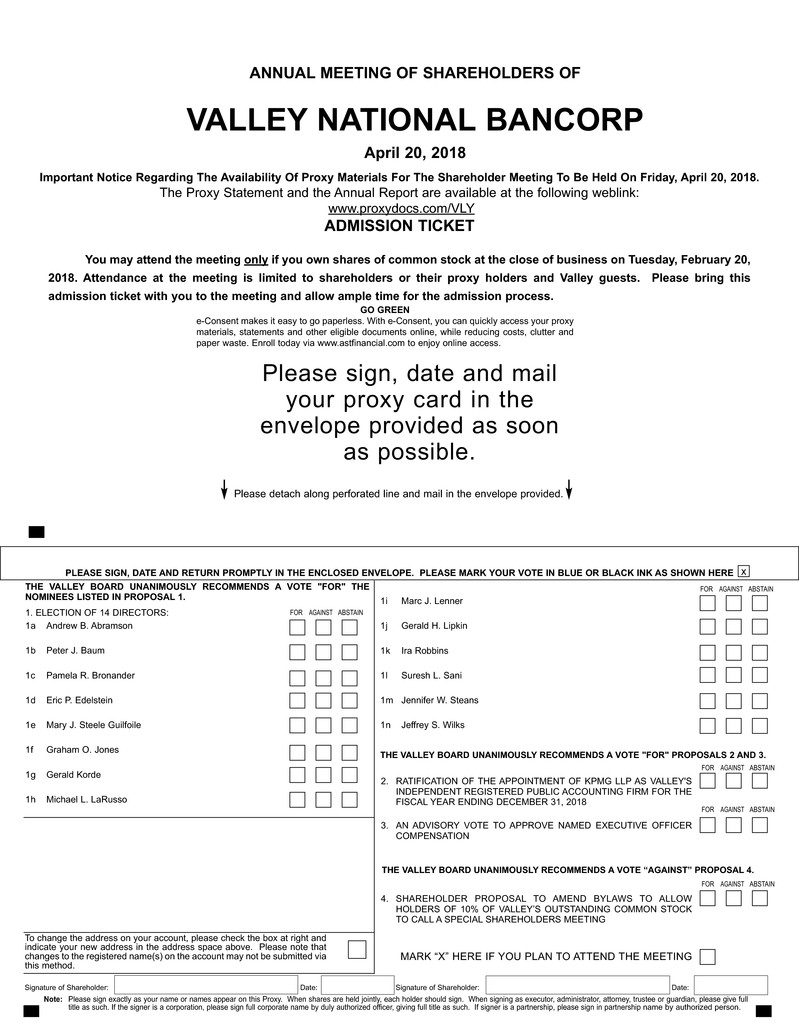| Statement and incorporated by reference in the Annual Report on Form 10-K for the year ended December 31, 2023. Suresh L. Sani Peter J. Baum Eric P. Edelstein Marc J. Lenner Jennifer W. Steans
EQUITY COMPENSATION PLAN INFORMATION | | | | | | | | | | Plan Category | Number of shares to be issued upon exercise of outstanding options and rights* | Weighted average exercise price on out-standing options and rights | Number of shares remaining available for future issuance under equity compensation plans (excluding shares reflected in the first column) | | Equity compensation plans approved by security holders | 2,119,424 |
| $ | 13.01 |
| 7,271,037 |
| | Equity compensation plans not approved by security holders | — |
| — |
| — |
| | Total | 2,119,424 |
| $ | 13.01 |
| 7,271,037 |
| | ____________ | | |
| | | * | Amount includes 446,980 options outstanding with a weighted average exercise price of $13.01 and 1,672,444 performance-based restricted stock units measured at maximum vesting at December 31, 2017. Amount does not include 1,771,702 outstanding restricted shares. |
| | | | | | | | 2018 Proxy Statement | 31
| | | | ITEM 2: ADVISORY VOTE ON OUR NAMED EXECUTIVE OFFICER COMPENSATION |
SUMMARY COMPENSATION TABLE
Executive Compensation Tables Summary Compensation Table The following table below summarizes all compensation in 2017, 20162023, 2022 and 20152021 earned by our chief executive officer, chief financial officer and the three most highly paid executive officers (NEOs)NEOs for services performed in all capacities for Valley and its subsidiaries. | | | | | | | | | | | | | | | | | | | | | | | | | Name and Principal Position | Year | Salary | Stock Awards(1) | Non-Equity Incentive Plan Compen-sation(2) | Change in Pension Value and Non-Qualified Deferred Compen-sation Earnings(3) | All Other Compen-sation(4) | Total | Total Without Change in Pension Value* | Gerald H. Lipkin(5) | 2017 | $ | 1,123,500 |
| $ | 1,800,000 |
| $ | 800,000 |
| $ | 825,168 |
| $ | 296,170 |
| $ | 4,844,838 |
| $ | 4,019,670 |
| | Chairman of the | 2016 | 1,123,500 |
| 1,750,000 |
| 750,000 |
| 909,924 |
| 188,536 |
| 4,721,960 |
| 3,812,036 |
| | Board and CEO | 2015 | 1,123,500 |
| 1,526,500 |
| 600,000 |
| 513,382 |
| 156,389 |
| 3,919,771 |
| 3,406,389 |
| | Ira Robbins | 2017 | 750,000 |
| 1,250,000 |
| 450,000 |
| 80,405 |
| 142,745 |
| 2,673,150 |
| 2,592,745 |
| | Senior EVP, Valley and President, Valley National Bank | 2016 | 525,000 |
| 750,000 |
| 250,000 |
| 45,718 |
| 77,757 |
| 1,648,475 |
| 1,602,757 |
| | Alan D. Eskow | 2017 | 575,000 |
| 675,000 |
| 250,000 |
| 15,279 |
| 156,701 |
| 1,671,980 |
| 1,656,701 |
| | Senior EVP, CFO and | 2016 | 545,750 |
| 675,000 |
| 200,000 |
| 0 |
| 118,714 |
| 1,539,464 |
| 1,539,464 |
| | Corporate Secretary | 2015 | 545,750 |
| 675,000 |
| 200,000 |
| 45,342 |
| 107,034 |
| 1,573,126 |
| 1,527,784 |
| Rudy E. Schupp(6) | 2017 | 750,000 |
| 800,000 |
| 450,000 |
| 0 |
| 159,688 |
| 2,159,688 |
| 2,159,688 |
| | President, Valley and Chief Banking Officer, Valley National Bank | 2016 | 525,000 |
| 750,000 |
| 250,000 |
| 0 |
| 69,392 |
| 1,594,392 |
| 1,594,392 |
| Ronald H. Janis(7) | 2017 | 500,000 |
| 800,000 |
| 250,000 |
| 0 |
| 50,131 |
| 1,600,131 |
| 1,600,131 |
| | Senior EVP, Valley and General Counsel | | | | | | |
|
|
|
| | ___________ | |
|
|
|
|
|
|
|
|
|
|
|
|
|
|
| | | | | | | | | | | | | | | | | | | | | | | | | | | Name and Principal Position | | Year | | Salary | | | Stock
Awards(1) | | | Non-Equity
Incentive Plan
Compensation(2) | | | Change in Pension
Value and
Non-Qualified
Deferred
Compensation
Earnings(3) | | | All Other
Compensation(4) | | | Total | | | | | | | | | | | Ira Robbins CEO | | 2023 | | | $1,000,000 | | | | $2,975,661 | | | | $ 921,875 | | | | $93,345 | | | | $ 425,582 | | | | $5,416,463 | | | | 2022 | | | 1,000,000 | | | | 3,060,578 | | | | 1,462,500 | | | | — | | | | 487,257 | | | | 6,010,335 | | | | 2021 | | | 1,000,000 | | | | 2,633,731 | | | | 1,380,000 | | | | — | | | | 336,099 | | | | 5,349,830 | | | | | | | | | | | Michael D. Hagedorn SEVP and CFO | | 2023 | | | 590,000 | | | | 684,879 | | | | 306,800 | | | | 8,593 | | | | 187,490 | | | | 1,777,762 | | | | 2022 | | | 590,000 | | | | 765,148 | | | | 501,000 | | | | — | | | | 89,446 | | | | 1,945,594 | | | | 2021 | | | 590,000 | | | | 830,207 | | | | 359,384 | | | | — | | | | 75,525 | | | | 1,855,116 | | | | | | | | | | | Thomas A. Iadanza President and Chief Banking Officer | | 2023 | | | 700,000 | | | | 755,729 | | | | 516,250 | | | | 16,985 | | | | 270,353 | | | | 2,259,317 | | | | 2022 | | | 700,000 | | | | 844,300 | | | | 845,000 | | | | — | | | | 253,583 | | | | 2,642,883 | | | | 2021 | | | 600,000 | | | | 916,089 | | | | 430,200 | | | | — | | | | 174,266 | | | | 2,120,555 | | | | | | | | | | | Raja A. Dakkuri SEVP and Chief Risk Officer | | 2023 | | | 500,000 | | | | 566,792 | | | | 295,000 | | | | 1,868 | | | | 340,329 | | | | 1,703,989 | | | | 2022 | | | 500,000 | | | | 633,226 | | | | 408,000 | | | | — | | | | 2,709,118 | | | | 4,250,344 | | | | 2021 | | | — | | | | — | | | | — | | | | — | | | | — | | | | — | | | | | | | | | | | Joseph V. Chillura SEVP, Commercial Banking | | 2023 | | | 510,000 | | | | 472,328 | | | | 290,700 | | | | 8,697 | | | | 135,134 | | | | 1,416,859 | | | | 2022 | | | 510,000 | | | | 527,688 | | | | 417,000 | | | | — | | | | 145,186 | | | | 1,599,874 | | | | 2021 | | | 510,000 | | | | 572,557 | | | | 324,679 | | | | — | | | | 69,454 | | | | 1,476,690 | |
| | (1) | | * | The amounts reported in this column differ, in certain cases substantially, from the amounts reported in the “Total” column required under SEC rules and should not be considered a substituteAmounts for the “Total” column of the Summary Compensation Table. | (1) | Stock awards reported in 20172023 reflect the aggregate grant date fair value of the restricted stocktime-based and performance based restricted stock unitperformance-based RSU awards under Accounting Standards Codification (ASC) Topic No. 718, Compensation-Stock Compensation ("(“ASC Topic 718"718”), excluding the effect of estimated forfeitures, granted by the Compensation Committee based on 20172023 results. For information on the assumptions used in the calculation of these amounts, see Note 1 to our consolidated financial statements contained in the Annual Report on Form 10-K for the year ended December 31, 2023. |
| The grant date fair value of time based restricted stocktime-based RSU awards reported in this column for each of our NEOs was as follows: Mr. Lipkin, $500,000;Robbins, $787,500; Mr. Eskow, $225,000;Hagedorn, $181,250; Mr. Robbins, $415,000;Iadanza, $200,000; Mr. Schupp, $260,000Dakkuri, $150,000; and Mr. Janis $200,000. Chillura, $125,000. |
| The amountamounts reported for Mr. Janis also includes his $200,000 sign-on restricted grant.the performance-based RSU awards are calculated based on the probable satisfaction of the performance goals for such awards and reflect the value of the awards at the target grant date value level (or 100%). Restrictions on time based restricted stock awards lapse at the rate of 33% per year. The grant date fair value of performance based restricted stock units reported in this column for each of our NEOs is the target value. Restrictions on performance basedperformance-based awards lapse based on achievement of the performance goals set forth in the performance restricted stock unit award agreement. Any shares earned based on achievement of the specific performance goals vest when the Compensation Committee certifies the payout level as a result of such performance achievementon February 1 following the three-year performance period.period and the Compensation Committee’s approval of the level of performance achievement. The value on the grant date of the performance based restricted stock unitperformance-based RSU awards based upon performance goal achievement at target and maximum would be as follows: |
| | | | | | | | | Name | Target Value at Grant Date | Maximum Value at Grant Date | Gerald H. Lipkin(5) | $ | 1,300,000 |
| $ | 1,950,000 |
| | Ira Robbins | 835,000 |
| 1,252,500 |
| | Alan D. Eskow | 450,000 |
| 675,000 |
| Rudy E. Schupp(6) | 540,000 |
| 810,000 |
| | Ronald H. Janis | 400,000 |
| 600,000 |
|
| | | | | | | | | | | Name | | Target Value at
Grant Date | | Maximum Value
at Grant Date | | | | | Ira Robbins | | | $ | 2,188,161 | | | | $ | 4,376,322 | | | | | | Michael D. Hagedorn | | | | 503,629 | | | | | 1,007,258 | | | | | | Thomas A. Iadanza | | | | 555,729 | | | | | 1,111,458 | | | | | | Raja A. Dakkuri | | | | 416,792 | | | | | 833,584 | | | | | | Joseph V. Chillura | | | | 347,328 | | | | | 694,658 | |
| | (2) | | (2) | Non-Equity awards earned forFor 2023, represents the years ending before 2017 were distributed as follows: 50% of the non-equity incentive award was paid on award and the remaining balance was paid in eight equal quarterly installments.cash in 2024 based on 2023 performance. |
| (3) | RepresentsAmounts reflect above-interest earnings under the Valley National Bancorp Deferred Compensation Plan (the “Deferred Compensation Plan” or “DCP”), and for Mr. Robbins, this amount also includes $56,521 attributable to the change in the actuarial present value of pension benefits from year to year, taking into account thehis age, of each NEO, a present value factor, and interest discount factor based on their remaining time until retirement. The increase in pensionthe present value of the accumulated benefits as of December 31, 2023 is attributable to the following sources: 1) passage of time, 2) a decrease in the discount rate from 4.11%5.40% to 3.69%, and5.11%. The annual change in present value of Mr. Robbins’ accumulated benefits as of December 31, 2022 was a net decrease of $313,675 from the present value reported as of December 31, 2021; therefore, the amount reported for Mr. Lipkin, 3) actuarial increases received for late retirement past age 70 ½.2022 is zero. The decrease in the present value of the accumulated benefits as of December 31, 2022 is attributable to the increase in the discount rate from 2.85% to 5.40%. |
| | | | | (4)56 | | | | 2024 Proxy Statement |
| | | | | ITEM 2: ADVISORY VOTE ON OUR NAMED EXECUTIVE OFFICER COMPENSATION | | | |
|
| The annual change in present value of Mr. Robbins’ accumulated benefits as of December 31, 2021 was a net decrease of $41,655 from the present value reported as of December 31, 2020; therefore, the amount reported for 2021 is zero. The decrease in the present value of the accumulated benefits as of December 31, 2021 is attributable to the increase in the discount rate from 2.52% to 2.85%. |
| (4) | All other compensation includes perquisites and other personal benefits paid in 20172023 including automobile, actual dividends paid upon vesting of time-based and driver (if applicable), accrued dividends on nonvested restricted stock,performance-based RSUs, 401(k) contribution payments, 401(k) SERPand deferred compensation contribution payments by Valley (including interest earned)the Company, GTL, club dues, and group term life insurance (seedeferred bonus payment to Mr. Dakkuri under legacy BLUSA long-term incentive plan. See the table below).below. |
| | | | | | | | | | | | | | | | | | | | | | | | | | | | | | | | | | | | | | | | | Name | | Auto(a) | | Actual Dividends
Paid in 2023(b) | | 401(k)(c) | | DCP(d) | | GTL(e) | | Club Dues | | Other | | Total | | | | | | | | | | | Ira Robbins | | | $ | 10,751 | | | | $ | 259,711 | | | | $ | 16,500 | | | | $ | 108,625 | | | | | $ 1,710 | | | | $ | 21,436 | | | | | $ 6,849 | | | | $ | 425,582 | | | | | | | | | | | | Michael D. Hagedorn | | | | 14,400 | | | | | 112,239 | | | | | 16,500 | | | | | 40,050 | | | | | 2,786 | | | | | — | | | | | 1,515 | | | | | 187,490 | | | | | | | | | | | | Thomas A. Iadanza | | | | 16,818 | | | | | 141,261 | | | | | 16,500 | | | | | 62,750 | | | | | 14,478 | | | | | 14,355 | | | | | 4,191 | | | | | 270,353 | | | | | | | | | | | | Raja A. Dakkuri | | | | 14,400 | | | | | 1,690 | | | | | 9,754 | | | | | 28,900 | | | | | 1,242 | | | | | — | | | | | 284,343 | | | | | 340,329 | | | | | | | | | | | | Joseph V. Chillura | | | | 14,400 | | | | | 62,899 | | | | | 16,500 | | | | | 31,850 | | | | | 2,374 | | | | | 7,111 | | | | | — | | | | | 135,134 | |
| | (a) | | | | 32 | 2018 Proxy Statement |
| | | | | | | | | | | | | | | | | | | | | | | | | | Name | Auto(1) | Accrued Dividends &
Interest Earned on Nonvested Stock Awards(2) | 401(k)(3) | 401(k) SERP(4) | GTL(5) | Other | Total | | | Gerald H. Lipkin | $ | 11,519 |
| $ | 183,394 |
| $ | 13,250 |
| $ | 88,007 |
| $ | 0 |
| $ | 0 |
| $ | 296,170 |
| | | Ira Robbins | 10,541 |
| 70,997 |
| 13,250 |
| 46,817 |
| 1,140 |
| 0 |
| 142,745 |
| | | Alan D. Eskow | 15,122 |
| 82,749 |
| 13,250 |
| 31,102 |
| 14,478 |
| 0 |
| 156,701 |
| | | Rudy E. Schupp | 5,204 |
| 70,997 |
| 13,250 |
| 46,817 |
| 14,478 |
| 8,942 |
| 159,688 |
| | | Ronald H. Janis | 19,933 |
| 3,783 |
| 0 |
| 21,931 |
| 4,484 |
| 0 |
| 50,131 |
| | | ____________ | | | | | | | |
| | | | | (1) | Auto represents, for Mr. Robbins and Mr. Iadanza, the cost to the Company of the portion of personal use of a company-owned vehicle by the NEO and driving services and parking (if applicable), and, for Mr. Hagedorn, Mr. Dakkuri and Mr. Chillura, a monthly automobile stipend during 2017.2023. |
| (b) | (2)Dividends paid on time-based and performance-based RSUs vesting in 2023. |
| (c) | Accrued dividends and interest on non-vested time and performance based restricted stock awards and performance based restricted stock units until such time as the vesting takes place. Dividends and interest on performance based awards and units are accrued at target and are only paid to the extent the underlying award vests. | | (3) | After one year of employment,Upon hire, the Company provides to all full timefull-time employees in the plan, including our NEOs, up to 100% of the first 4% of pay contributed and 50% of the next 2% of pay contributed. An employee must save at least 6% to get the full match (5%) under the Company’s 401(k) Plan. |
| (d) | (4) | Effective January 1, 2017, Valley established the Valley National Bancorp Deferred Compensation Plan for the benefit of certain eligible employees, see “Deferred Compensation Plan” under “2023 Nonqualified Deferred Compensation Plan under the 2017 Pension BenefitsCompensation” below. If the NEO utilizes the Company’s 401(k) Plan to the maximum, for amounts over the maximum compensation amount allowed under the 401(k), the NEO may elect to defer 5% of the excess and the Company will match that deferral compensation. |
| (e) | (5) | GTL or Group Term Life Insurance (“GTL”) represents the taxable amount for over $50,000 of life insurance for benefits equal to two times salary. This benefit is provided to all full timefull-time employees. |
Grants of Plan-Based Awards | | | | | | | | | | | | | | | | | | | | | | | | | | | | | | | | | | | | | | | | | | | | | | Estimated Possible
Payouts Under
Non-Equity Incentive Plan
Awards(1) | | Estimated Possible Payouts
Under Equity Incentive
Plan Awards(1) | | All Other Stock
Awards:
Number of
Shares of
Stock (#)(1) | | Grant Date
Fair Value
of Stock
Awards(2) ($) | Name | | Grant
Date | | Target ($) | | Maximum ($) | | Threshold (#) | | Target (#) | | Maximum (#) | | | | | | | | | | | Ira Robbins | | | | 2/20/2024 | | | | | $1,250,000 | | | | | $2,500,000 | | | | | 138,808 | | | | | 277,615 | | | | | 555,230 | | | | | — | | | | | $2,188,161 | | | | | | | | | | | | | | | | 2/20/2024 | | | | | — | | | | | — | | | | | — | | | | | — | | | | | — | | | | | 92,539 | | | | | 787,500 | | | | | | | | | | | | Michael D. Hagedorn | | | | 2/20/2024 | | | | | 472,000 | | | | | 944,000 | | | | | 31,948 | | | | | 63,896 | | | | | 127,792 | | | | | — | | | | | 503,629 | | | | | | | | | | | | | | | | 2/20/2024 | | | | | — | | | | | — | | | | | — | | | | | — | | | | | — | | | | | 21,299 | | | | | 181,250 | | | | | | | | | | | | Thomas A. Iadanza | | | | 2/20/2024 | | | | | 700,000 | | | | | 1,400,000 | | | | | 35,253 | | | | | 70,506 | | | | | 141,012 | | | | | — | | | | | 555,729 | | | | | | | | | | | | | | | | 2/20/2024 | | | | | — | | | | | — | | | | | — | | | | | — | | | | | — | | | | | 23,502 | | | | | 200,000 | | | | | | | | | | | | Raja A. Dakkuri | | | | 2/20/2024 | | | | | 400,000 | | | | | 800,000 | | | | | 26,440 | | | | | 52,879 | | | | | 105,758 | | | | | — | | | | | 416,792 | | | | | | | | | | | | | | | | 2/20/2024 | | | | | — | | | | | — | | | | | — | | | | | — | | | | | — | | | | | 17,627 | | | | | 150,000 | | | | | | | | | | | | Joseph V. Chillura | | | | 2/20/2024 | | | | | 408,000 | | | | | 816,000 | | | | | 22,033 | | | | | 44,066 | | | | | 88,132 | | | | | — | | | | | 347,328 | | | | | | | | | | | | | | | | 2/20/2024 | | | | | — | | | | | — | | | | | — | | | | | — | | | | | — | | | | | 14,689 | | | | | 125,000 | |
| (1) | Represents the target and maximum non-equity incentive compensation amounts for performance during 2023. The Compensation Committee set target awards under our non-equity incentive plan for 2023 as follows: Mr. Lipkin has a $50,000 life insurance policy with theRobbins as CEO, 125% of salary; Messrs. Hagedorn, Dakkuri, and Chillura, 80% of salary; and Mr. Iadanza, 100% of salary. Awards were paid based upon achievement of Company and is not subject to a taxable amount. |
| | | (5) | In 2017, Mr. Lipkin notified the Company of his intention to retire as CEO effective December 31, 2017 and as an employee effective as of April 2018. | (6) | Mr. Schupp retired on January 15, 2018. | (7) | In joining the Company on January 2, 2017, Mr. Janis received a sign on bonus of $200,000 of restricted stock which vested after six months and a $50,000 cash bonus. His awards for service in 2017 were a $200,000 cash bonus and a $600,000 equity award. |
2017 GRANTS OF PLAN-BASED AWARDS
The following table represents the grants of awards to the NEOs in 2018 for 2017 performance under the Executive Incentive Plan and Long-Term Stock Incentive Plan.
| | | | | | | | | | | | | | | | | | | | | | | | | | Estimated Possible Payouts Under
Non-Equity Incentive Plan Awards(1) | Estimated Possible Payouts
Under Equity Incentive Plan Awards (#)(1) | All Other
Stock
Awards:
Number of
Shares of Stock(1) | Grant Date
Fair Value of Stock Awards(2) | | Name | Grant Date | | Threshold | Target | Maximum | Threshold | Target | Maximum | | | | Gerald H. Lipkin | 2/1/2018 | |
| $ | 561,750 |
| $ | 1,123,500 |
| 51,711 |
| 103,421 |
| 155,132 |
| | $ | 1,300,000 |
| | | 2/1/2018 | | | | | | | | 39,777 |
| 500,000 |
| | Ira Robbins | 2/1/2018 | |
| 262,500 |
| 525,000 |
| 33,214 |
| 66,428 |
| 99,642 |
|
| 835,000 |
|
| 2/1/2018 | | | | | | | | 33,015 |
| 415,000 |
| | Alan D. Eskow | 2/1/2018 | |
| 201,250 |
| 402,500 |
| 17,900 |
| 35,800 |
| 53,700 |
|
| 450,000 |
| | | 2/1/2018 | | | | | | | | 17,900 |
| 225,000 |
| | Rudy E. Schupp | 2/1/2018 | |
| 262,500 |
| 525,000 |
| 21,480 |
| 42,959 |
| 64,439 |
|
| 540,000 |
|
| 2/1/2018 | | | | | | | | 20,684 |
| 260,000 |
| | Ronald H. Janis | 2/1/2018 | |
| 125,000 |
| 250,000 |
| 15,911 |
| 31,822 |
| 47,733 |
|
| 400,000 |
| | | 2/1/2018 | | | | | | | | 15,911 |
| 200,000 |
| | | 1/3/2017 | | | | | | | | 17,182 |
| 200,000 |
| | ____________ | | | | | | | | |
|
| |
| | | (1) | As discussed in the Compensationindividual goals. See “Compensation Discussion and Analysis, in January 2017, the Compensation Committee assigned a percentage shareAnalysis” beginning on page 42 of the 2017 EIP bonus pool of 5% of our 2017 net income before income taxes to each of our NEOs. The EIP permits the Compensation Committee to determine to pay earned awards, in whole or in part, in the form of cash or equity awards granted under our Long-Term Stock Incentive Plan. For 2017, the Compensation Committee determined that any cash awards that may be earned under the EIP bonus pool would be limited to a pre-established range set as a percentage of the particular NEO’s base salary. Each NEO could earn between 0% to 200% of his target cash award as reported under “Estimated Possible Payouts Under Non-Equity Incentive Plan Awards” above. See table (“EIP Cash Award”) in the Compensation Discussion and Analysis for information regarding the salary amount used to determine the range of each NEO’s potential cash awards under the 2017 EIP bonus pool.this Proxy Statement. The Compensation Committee awarded each NEO the cash amount reflected in the “Non-Equity“Non-Equity Incentive Plan Compensation” column of the Summary Compensation Table for 2017.2023. The Compensation Committee also granted each NEO an award of time-based restricted stock out ofRSUs under the 2017 EIP bonus pool2023 ICP (reported above under “All Other Stock Awards: Number of Shares of Stock”). The Compensation Committee also made grants to the NEOs under the 2017 Long-Term Incentive Stock Plan2023 ICP in the form of performance based restricted stock unitsperformance-based RSUs (reported above under “Estimated Possible Payouts Under Equity Incentive Plan Awards”). The threshold amounts reported above for the performance based restricted stock unitperformance-based RSU awards represent the number of shares that would be earned based on achievement of threshold amounts under both the growth in tangible book valueGITBV and relative TSR performance metrics measured over the cumulative three-year performance period. The January 3, 2017 award reflects Mr. Janis's sign-on restricted stock grant. See our Compensation“Compensation Discussion and AnalysisAnalysis” for information regarding these time-based restricted stockRSUs and performance based restricted stock unitperformance-based RSU awards. |
| (2) | See grant date fair value details under footnote (1) of the Summary Compensation Table above. |
| | | | |
| | | | ITEM 2: ADVISORY VOTE ON OUR NAMED EXECUTIVE OFFICER COMPENSATION |
Restrictions on performance basedperformance-based awards lapse based on achievement of the performance goals set forth in the performance restricted stock unitperformance-based RSU award agreement. Any shares earned based on achievement of the specific performance goals vest whenfollowing the completion of the three-year performance period and the Compensation Committee certifiesCommittee’s approval of the payout level as a result of such performance achievement. Restrictions on time based restricted stocktime-based RSU awards lapse at the rate of 33% per year. year commencing with the first year after the date of grant.Dividends are credited on restricted stock and restricted stock unitsRSUs at the same time and in the same amount as dividends paid to all other common shareholders. Credited dividends are accumulated and paid upon vesting and are subject to the same time basedtime-based and performance basedperformance-based restrictions as the underlying restricted stock and units. Upon a “change in control,” as defined in that plan,the 2023 ICP, following termination of employment, all restrictions on shares of time basedtime-based restricted stock will lapse and restrictions on shares of performance based restricted stock unitsperformance-based RSUs will lapse at target. target, unless otherwise provided in the grant agreement.The per share grant date fair values under ASC Topic 718 of each share of time based restricted stockunderlying time-based and performance based restricted stock unitsperformance-based RSUs (with no market condition vesting requirement) was $12.57$8.51 per share awarded on February 1, 2018. Performance based restricted stock units20, 2024. Performance-based RSUs with market condition vesting requirements (i.e., TSR) awarded on February 1, 201820, 2024 had a $11.71$6.94 per share grant date fair value.
| | | | | ITEM 2: ADVISORY VOTE ON OUR NAMED EXECUTIVE OFFICER COMPENSATION | | | | | | 34 | 2018 Proxy Statement
|
OUTSTANDING EQUITY AWARDS AT FISCAL YEAR-END
Outstanding Equity Awards at Fiscal Year-End The following table below represents stock option, restricted stock and restricted stock unitRSU awards outstanding for each NEO as of December 31, 20172023 (including February 1, 201820, 2024 awards which were based on 20172023 performance). All awards have been adjusted for stock dividends and stock splits, as applicable. | | | | | | | | | | | | | | | | | | | | | | | | | | Option Awards(1) | | Stock Awards(2) | | Name | Grant Date | Number of
Securities
Underlying
Unexercised
Options
Exercisable | Number of
Securities
Underlying
Unexercised
Options
Unexercisable | Option
Exercise
Price | Option
Expiration
Date | | Number of Shares
or Units of Stock
That Have Not
Vested | Market Value
of Shares or
Units of
Stock That
Have Not
Vested(3) | Equity Incentive
Plan Awards:
Number of
Unearned Shares
or Units That
Have Not Vested | Equity Incentive
Plan Awards:
Market Value of
Unearned
Shares or Units
That Have Not
Vested(3) | | Gerald H. Lipkin | 2/1/2018 | | | | | | 39,777 |
| $ | 446,298 |
| 155,132 |
| $ | 1,740,581 |
| | | 1/24/2017 | | | | | | 39,858 |
| 447,207 |
| 172,719 |
| 1,937,907 |
| | | 1/29/2016 | | | | | |
|
|
|
| 202,967 |
| 2,277,290 |
| | | 1/27/2016 | | | | | | 29,586 |
| 331,955 |
|
|
|
|
| | | 1/30/2015 | | | | | | 13,661 |
| 153,276 |
| 122,951 |
| 1,379,510 |
| | | 11/15/2010 | 44,015 |
| 0 |
| $ | 11.91 |
| 11/15/2020 | | | |
| | | | 2/12/2008 | 44,671 |
| 0 |
| 14.65 |
| 2/12/2018 | | | | | | | |
|
|
|
|
|
|
|
| | | | | | | Total awards (#) | | 88,686 |
| 0 |
| | | | 122,882 |
| $ | 1,378,736 |
| 653,769 |
| $ | 7,335,288 |
| | Market value of in-the-money options ($) (3) | $ | 0 |
| 0 |
| | | | | | | | | Ira Robbins | 2/1/2018 | | | | | | 33,015 |
| $ | 370,428 |
| 99,642 |
| $ | 1,117,983 |
| | | 1/24/2017 | | | | | | 22,143 |
| 248,444 |
| 66,431 |
| 745,356 |
| | | 1/29/2016 | | | | | |
|
| | 77,115 |
| 865,230 |
| | | 1/27/2016 | | | | | | 17,259 |
| 193,646 |
| | | | | 1/30/2015 | | | | | | 3,643 |
| 40,874 |
| 32,787 |
| 367,870 |
| | | 11/17/2008 | 1,216 |
| 0 |
| $ | 14.24 |
| 11/17/2018 | | | | | | | | | | | | | | | | | | | Total awards (#) | | 1,216 |
| 0 |
| | | | 76,060 |
| $ | 853,392 |
| 275,975 |
| $ | 3,096,439 |
| | Market value of in-the-money options ($) (3) | 0 |
| 0 |
| | | | | | | | | Alan D. Eskow | 2/1/2018 | | | | | | 17,900 |
| $ | 200,838 |
| 53,700 |
| $ | 602,514 |
| | | 1/24/2017 | | | | | | 19,929 |
| 223,603 |
| 59,787 |
| 670,810 |
| | | 1/29/2016 | | | | | |
|
|
|
| 79,319 |
| 889,959 |
| | | 1/27/2016 | | | | | | 17,751 |
| 199,166 |
|
|
|
|
| | | 1/30/2015 | | | | | | 8,197 |
| 91,970 |
| 73,770 |
| 827,699 |
| | | 11/15/2010 | 21,170 |
| 0 |
| $ | 11.91 |
| 11/15/2020 | | | | | | | | 2/12/2008 | 21,059 |
| 0 |
| 14.65 |
| 2/12/2018 | | | | | | | |
|
|
|
|
|
|
|
| | | | | | | Total awards (#) | | 42,229 |
| 0 |
| | | | 63,777 |
| $ | 715,577 |
| 266,576 |
| $ | 2,990,982 |
| | Market value of in-the-money options ($) (3) | 0 |
| 0 |
| | | | | | | | | Rudy E. Schupp | 2/1/2018 | | | | | | 20,684 |
| $ | 232,074 |
| 64,439 |
| $ | 723,006 |
| | | 1/24/2017 | | | | | | 22,143 |
| 248,444 |
| 66,431 |
| 745,356 |
| | | 1/29/2016 | | | | | |
|
|
|
| 77,115 |
| 865,230 |
| | | 1/27/2016 | | | | | | 17,259 |
| 193,646 |
| | | | | 1/30/2015 | | | | | | 3,643 |
| 40,874 |
| 32,787 |
| 367,870 |
| | | | | | | | | | | | | | Total awards (#) | | 0 |
| 0 |
| | | | 63,729 |
| $ | 715,038 |
| 240,772 |
| $ | 2,701,462 |
| | | | | | | | | | | | | | Ronald H. Janis | 2/1/2018 | | | | | | 15,911 |
| $ | 178,521 |
| 47,733 |
| $ | 535,564 |
| | | | | | | | | | | | | | Total awards (#) | | 0 |
| 0 |
| | | | 15,911 |
| $ | 178,521 |
| 47,733 |
| $ | 535,564 |
| | Market value of in-the-money options ($) (3) | 0 |
| 0 |
| | | | | | | |
____________
| | | | | | | | | | | | | | | | | | | | | | | | | | | | | | | | | | | | | | | | | | | | | | | | | | | Option Awards | | Stock Awards(1) | Name | | Grant
Date | | Number of
Securities
Underlying
Unexercised
Options
Exercisable | | Number of
Securities
Underlying
Unexercised
Options
Unexercisable | | Option
Exercise
Price ($) | | Option
Expiration
Date | | Number of
Shares or
Units of
Stock
That Have
Not
Vested (#) | | Market Value
of Shares or
Units of
Stock That
Have Not
Vested ($) | | Plan Awards:
Number of
Unearned
Shares or
Units That
Have Not
Vested (#) | | Equity Incentive Plan
Awards:
Market Value
of Unearned
Shares or
Units That
Have Not
Vested(2) ($) | | | | | | | | | | | | Ira Robbins | | | | 2/20/2024 | | | | | | | | | | | | | | | | | | | | | | | | | 92,539 | | | | $ | 1,004,974 | | | | | 555,230 | | | | $ | 6,029,798 | | | | | | | | | | | | | | | | | 2/22/2023 | | | | | | | | | | | | | | | | | | | | | | | | | 60,823 | | | | | 660,538 | | | | | 364,934 | | | | | 3,963,183 | | | | | | | | | | | | | | | | | 2/15/2022 | | | | | | | | | | | | | | | | | | | | | | | | | 30,012 | | | | | 325,930 | | | | | 270,108 | | | | | 2,933,373 | | | | | | | | | | | | | | | | | 2/16/2021 | | | | | | | | | | | | | | | | | | | | | | | | | 15,603 | | | | | 169,449 | | | | | 280,852 | | | | | 3,050,053 | | | | | | | | | | | | | Total awards | | | | | | | | | | | | | | | | | | | | | | | | | | | | | 198,977 | | | | $ | 2,160,891 | | | | | 1,471,124 | | | | $ | 15,976,407 | | | | | | | | | | | | | Michael D. Hagedorn | | | | 2/20/2024 | | | | | | | | | | | | | | | | | | | | | | | | | 21,299 | | | | $ | 231,307 | | | | | 127,792 | | | | $ | 1,387,821 | | | | | | | | | | | | | | | | | 2/22/2023 | | | | | | | | | | | | | | | | | | | | | | | | | 15,206 | | | | | 165,137 | | | | | 91,234 | | | | | 990,801 | | | | | | | | | | | | | | | | | 2/15/2022 | | | | | | | | | | | | | | | | | | | | | | | | | 9,461 | | | | | 102,746 | | | | | 85,144 | | | | | 924,664 | | | | | | | | | | | | | | | | | 2/16/2021 | | | | | | | | | | | | | | | | | | | | | | | | | 5,656 | | | | | 61,424 | | | | | 101,808 | | | | | 1,105,635 | | | | | | | | | | | | | Total awards | | | | | | | | | | | | | | | | | | | | | | | | | | | | | 51,622 | | | | $ | 560,614 | | | | | 405,978 | | | | $ | 4,408,921 | | | | | | | | | | | | | Thomas A. Iadanza | | | | 2/20/2024 | | | | | | | | | | | | | | | | | | | | | | | | | 23,502 | | | | $ | 255,232 | | | | | 141,012 | | | | $ | 1,531,390 | | | | | | | | | | | | | | | | | 2/22/2023 | | | | | | | | | | | | | | | | | | | | | | | | | 16,779 | | | | | 182,220 | | | | | 100,672 | | | | | 1,093,298 | | | | | | | | | | | | | | | | | 2/15/2022 | | | | | | | | | | | | | | | | | | | | | | | | | 10,440 | | | | | 113,378 | | | | | 93,952 | | | | | 1,020,319 | | | | | | | | | | | | | | | | | 2/16/2021 | | | | | | | | | | | | | | | | | | | | | | | | | 6,241 | | | | | 67,777 | | | | | 112,340 | | | | | 1,220,012 | | | | | | | | | | | | | Total awards | | | | | | | | | | | | | | | | | | | | | | | | | | | | | 56,962 | | | | $ | 618,607 | | | | | 447,976 | | | | $ | 4,865,019 | | | | | | | | | | | | | Raja A. Dakkuri | | | | 2/20/2024 | | | | | | | | | | | | | | | | | | | | | | | | | 17,627 | | | | $ | 191,429 | | | | | 105,758 | | | | $ | 1,148,532 | | | | | | | | | | | | | | | | | 2/22/2023 | | | | | | | | | | | | | | | | | | | | | | | | | 12,584 | | | | | 136,662 | | | | | 75,504 | | | | | 819,973 | | | | | | | | | | | | | | | | | 4/1/2022 | | | | | | | | | | | | | | | | | | | | | | | | | 7,681 | | | | | 83,416 | | | | | 69,126 | | | | | 750,708 | | | | | | | | | | | | | | | | | 8/22/2018 | | | | | 402,380 | | | | | | | | | $ | 8.47 | | | | | 8/22/2025 | | | | | | | | | | | | | | | | | | | | | | | | | | | | | | | | | Total awards | | | | | | | | | | | | | | | | | | | | | | | | | | | | | 37,892 | | | | $ | 411,507 | | | | | 250,388 | | | | $ | 2,719,213 | | | | | | | | | | | | | Joseph V. Chillura | | | | 2/20/2024 | | | | | | | | | | | | | | | | | | | | | | | | | 14,689 | | | | $ | 159,523 | | | | | 88,132 | | | | $ | 957,114 | | | | | | | | | | | | | | | | | 2/22/2023 | | | | | | | | | | | | | | | | | | | | | | | | | 10,487 | | | | | 113,889 | | | | | 62,920 | | | | | 683,311 | | | | | | | | | | | | | | | | | 2/15/2022 | | | | | | | | | | | | | | | | | | | | | | | | | 6,525 | | | | | 70,862 | | | | | 58,720 | | | | | 637,699 | | | | | | | | | | | | | | | | | 2/16/2021 | | | | | | | | | | | | | | | | | | | | | | | | | 3,901 | | | | | 42,365 | | | | | 70,214 | | | | | 762,524 | | | | | | | | | | | | | | | | | 3/1/2017 | | | | | 55,657 | | | | | | | | | $ | 6.72 | | | | | 3/1/2027 | | | | | | | | | | | | | | | | | | | | | | | | | | | | | | | | | | | | | 3/1/2016 | | | | | 17,508 | | | | | | | | | $ | 5.74 | | | | | 3/1/2026 | | | | | | | | | | | | | | | | | | | | | | | | | | | | | | | | | Total awards | | | | | | | | | | | | | | | | | | | | | | | | | | | | | 35,602 | | | | $ | 386,639 | | | | | 279,986 | | | | $ | 3,040,648 | |
| | (1) | | | 2018 Proxy Statement | 35 | |
| | | (1) | All stock option awards are currently exercisable, however, the exercise prices may be higher than Valley's market price. | (2) | Restrictions on time based restricted stocktime-based RSU awards (reported above under “Number of Shares or Units of Stock That Have Not Vested”) lapse at the rate of 33% per year commencing with the first anniversary ofyear after the date of grant. The 2018 awards represent the time-based restricted stock granted out of the 2017 EIP bonus pool. |
| Restrictions on performance based restricted stock unitperformance-based RSU awards (reported above under “Equity Incentive Plan Awards: Number of Unearned Shares or Units That Have Not Vested”) lapse based on achievement of the performance goals set forth in the award agreement. Dividends are credited on these awards at the same time and in the same amount as dividends paid to all other common shareholders. Credited dividends are accumulated and paid upon vesting and are subject to the same time basedtime-based or performance basedperformance-based restrictions as the underlying restricted stock unit.RSU. |
| | | | |
| | | | ITEM 2: ADVISORY VOTE ON OUR NAMED EXECUTIVE OFFICER COMPENSATION |
| The award amount in the "Equity“Equity Incentive Plan Awards: Number of Unearned Shares or Units That Have Not Vested"Vested” column represents the number of shares that may be earned based on maximum performance achievement over the cumulative three-year performance period with respect to both the growth in tangible book valueGITBV and total shareholder returnTSR performance metrics, for the 1/29/20162/16/2021 award, 1/24/20172/15/2022 award, 2/22/2023 award and 2/1/201820/2024 award. |
(3)(2) | At per share closing market price of $11.22$10.86 as of December 31, 2017.29, 2023 (the last trading day of 2023). |
2017 STOCK VESTED
2023 Stock Vested The following table below shows the restricted stocktime-based RSU awards held by our NEOs that vested by NEOs in 20172023, as well as performance-based RSU awards which vested in early 2024 based on the three-year performance period ended December 31, 2023, and the value realized upon vesting. None of our NEOs exercised any options in 2017. | | | | | | | | | Stock Awards | | Name | Number of Shares Acquired
Upon Vesting (#) | Value Realized on Vesting ($)(*) | | Gerald H. Lipkin | 161,973 |
| $ | 2,009,129 |
| | Ira Robbins | 40,484 |
| 503,682 |
| | Alan D. Eskow | 86,095 |
| 1,071,636 |
| | Rudy E. Schupp | 33,092 |
| 414,460 |
| | Ronald H. Janis | 17,182 |
| 202,919 |
| | ____________ | | |
2023. | | | | | | | | | | | | | | Stock Awards | Name | | Number of Shares
Acquired Upon
Vesting (#) | | Value
Realized on
Vesting
($)(*) | | | | | Ira Robbins | | | | 266,303 | | | | $ | 2,412,217 | | | | | | Michael D. Hagedorn | | | | 96,801 | | | | | 877,595 | | | | | | Thomas A. Iadanza | | | | 107,739 | | | | | 979,359 | | | | | | Raja A. Dakkuri | | | | 3,840 | | | | | 35,482 | | | | | | Joseph V. Chillura | | | | 65,991 | | | | | 596,106 | |
| | * | | * | The valueValue realized onupon vesting of restricted stock represents the aggregate dollar amount realized upon vestingRSU awards is calculated by multiplying the number of shares of restricted stock/unitsRSUs that vested by the fair market value of the underlying shares on the vesting date. Included above is |
| This amount includes the value attributable to the vesting of the final portion of the performance-based RSU awards granted on 1/30/2015February 16, 2021 for Mr. Lipkin (78,074Robbins (222,986 shares), Mr. Robbins (20,820Hagedorn (80,831 shares), Mr. Eskow (46,844Iadanza (89,193 shares), and Mr. Schupp (20,820)Chillura (55,747 shares). Mr. Dakkuri did not join the Company until April 2022, and therefore was not a recipient of this grant. These shares vested based on the achievement of the GITBV and TSR performance goals set forth in the award agreement based on the applicable growth in tangible book value conditions measured over the three-year performance period ending December 31, 2017. 2023. |
| Dividends are credited on thesetime-based and performance-based RSU awards at the same time and in the same amount as dividends paid to all other common shareholders. Credited dividends are accumulated and paid upon vesting and are subject to the same time basedtime-based or performance basedperformance-based restrictions as the underlying restricted stock. The performance based awards granted on 1/30/2015 subject to vesting based on relative TSR performance lapsed without any vesting.RSUs. |
2017 PENSION BENEFITS
PENSION PLAN
2023 Pension Benefits Pension Plan.Valley maintains a non-contributory, defined benefit pension plan (the "Pension Plan"“Pension Plan”) for all eligible employees which was frozen effective January 1, 2014. The annual retirement benefit under the Pension Plan generally was (i) 0.85% of the employee’s average final compensation up to the employee’s average social security wage base plus (ii) 1.15% of the employee’s average final compensation in excess of the employee’s average social security wage base up to the annual compensation limit under the law, (iii) multiplied by the years of credited service (up to a maximum of 35 years). Employees who were participants in the Pension Plan on December 31, 1988 are entitled to the higher of the foregoing or their accrued benefit as of December 31, 1988 under the terms of the plan then in effect. An employee’s “average final compensation” is the employee’s highest consecutive five-year average of the employee’s annual salary (excluding non-equity compensation, overtime pay and other special pay), i.e., the amount listed as “Salary” in the Summary Compensation Table, subject to each year’s annual compensation limit.salary. Employees hired on or after July 1, 2011, including Mr. SchuppHagedorn, Mr. Iadanza, Mr. Dakkuri, and Mr. Janis,Chillura, are not eligible to participate in the Pension Plan. As a result of amendments to the Pension Plan adopted in 2013, participants will not accrue further benefits and their pension benefits will be determined based on their compensation and service up to December 31, 2013. Plan benefits will not increase for any pay or service earned after such date. BENEFIT EQUALIZATION PLAN
Benefit Equalization Plan.Valley maintains a Benefit Equalization Plan ("BEP"(“BEP”) which provides retirement benefits in excess of the amounts payable from the Pension Plan for certain highly compensated executive officers. The BEP was first adopted January 1, 1989 andofficers, which was frozen effective January 1, 2014. Benefits wereare generally determined as follows: (i) the benefit calculated under Valley pension plan formula in effect prior to January 1, 1989 and without regard to the limits on recognized compensation and maximum benefits payable from a qualified defined benefit plan, minus (ii) the individual’s pension plan benefit. In general, officers of Valley who are participants in the Pension Plan and who received annual compensation in excess of the compensation limits under the qualified plan were eligible to participate in the BEP. Mr. Lipkin, Mr. Robbins and Mr. Eskow were participants in the BEP. One other executive officer participatedis a participant in the BEP. Executives hired on or after July 1, 2011, including Mr. SchuppHagedorn, Mr. Iadanza, Mr. Dakkuri, and Mr. Janis,Chillura, are not eligible to participateparticipants in the BEP. As a result of amendments to the BEP adopted in 2013, participants will not accrue further benefits and their benefits will be determined based on their compensation for service and years of service up to December 31, 2013. Benefits under the BEP will not increase for any pay or service earned after
| | | | | ITEM 2: ADVISORY VOTE ON OUR NAMED EXECUTIVE OFFICER COMPENSATION | | | |
|
such date except participants may be granted up to three additional years of service if employment is terminated in the event of a change in control. CIC. The following table below shows each pension plan that the NEO participates in, the number of years of credited service and the present value of accumulated benefits as of December 31, 2017. | | | | | | | | Name | Plan Name | # of
Years
Credited
Service | Present Value of
Accu-mulated
Benefits ($) | | Gerald H. Lipkin | VNB Pension Plan | 35 | $ | 2,371,591 |
| | | VNB BEP | 37 | 8,352,547 |
| | Alan D. Eskow | VNB Pension Plan | 22 | 768,734 |
| | | VNB BEP | 22 | 1,613,501 |
| | Ira Robbins | VNB Pension Plan | 16 | 433,438 |
|
| VNB BEP | 16 | 178,276 |
|
2023. | | | | | | | | | | | | | | | | Name | | Plan Name | | # of Years Credited
Service | | Present Value of
Accumulated
Benefits ($) | | | | | | Ira Robbins | | | | Pension Plan | | | | | 16 | | | | $ | 416,714 | | | | | | | | | | | BEP | | | | | 16 | | | | | 174,434 | |
Present values of the accumulated benefits under the BEP and Pension Plan were determined as of January 1, 20182024 based upon the accrued benefits under each plan as of December 31, 20172023 and valued in accordance with the following principal actuarial assumptions: (i) post-retirement mortality in accordance with the RP-2014Pri-2012 White Collar Tables rolled back to 2006,(base year 2006), projected generationally with Scale MP-2017,MP-2021, (ii) interest at an annual effective rate of 3.69%5.11% compounded annually, (iii) retirement at the earliest age (subject to a minimum age of 55 and a maximum age equal to the greater of 65 and the participant’s age on January 1, 2018)2024) at which unreduced benefits would be payable assuming continuation of employment and (iv) for the BEP payment is based on an election by the participant and for the Pension Plan it is assumed that 50%60% of male participants will elect a joint and two-thirds survivor annuity and 50%40% will elect a straight life annuity (except for Mr. Lipkin whose benefits are assumed to be payable in the form of a joint and two-thirds survivor annuity as described below)annuity. Early Retirement Benefits. Due to his anticipated retirement the present value of Mr. Lipkin's Pension Plan and BEP accrued benefits assume commencement at May 1, 2018. Gerald H. Lipkin.Pursuant to an amended and restated agreement dated January 24, 2017, an annual combined benefit from the Pension Plan, the BEP and, to the extent necessary, from the Company, in the form of a joint and two-thirds survivor annuity (the “Annual Combined Benefit”) will be provided to Mr. Lipkin upon his retirement and will continue for as long as Mr. Lipkin survives. The Annual Combined Benefit is estimated to be $866,478 as of December 31, 2017. The Annual Combined Benefit is estimated to be $890,100 as of Mr. Lipkin’s anticipated retirement date of May 1, 2018.
The agreement provides that, should Mr. Lipkin survive past the tenth anniversary of his retirement (the “Initial Ten Year Period”), and should his spouse survive him, she will be entitled to a survivor benefit of two-thirds of the Annual Combined Benefit per year for the remainder of her life (the
“Annual Post 10 Year Spousal Survivor Benefit”), which is estimated to be $577,652 as of December 31, 2017 ($593,436 as of May 1, 2018). If Mr. Lipkin dies (i) before commencing receipt of benefits under the Pension Plan or (ii) before the end of the Initial Ten Year Period, and, in either case, if his spouse survives him, she will be entitled to an annual survivor benefit equal to the Annual Combined Benefit through the end of the Initial Ten Year Period (the “Annual 10 Year Spousal Survivor Benefit”) and, thereafter, the Annual Post 10 Year Spousal Survivor Benefit. In the event that both Mr. Lipkin and his spouse die prior to the end of the Initial Ten Year Period, the estate of the last surviving of Mr. Lipkin and his spouse will be entitled to a lump sum payment equal to the Annual Combined Benefit multiplied by the number of years (including fractional years) from the date of decease to the end of the Initial Ten Year Period (the “10 Year Estate Benefit”). The foregoing description assumes that pension benefits under the Pension Plan and the BEP are paid to Mr. Lipkin in the form of a joint and two-thirds survivor annuity with his current wife. The agreement provides that for both the Pension Plan and the BEP the actuarial adjustment from the single life annuity to the joint and two-thirds survivor annuity in the BEP will be made using the actuarial factor defined in the Pension Plan.
The agreement also specifies the manner in which Mr. Lipkin’s annuity payments are to be actuarially converted into a lump sum in the event of a change in control. Mr. Lipkin elected to take his BEP benefits as a lump sum in the event of a change in control and is the only participant to have made that election. Under the BEP, the lump sum is to be calculated using the lesser of 6% or the applicable interest rate under the Pension Plan. Under the agreement the actuarial assumptions used to convert the guaranteed annuity benefit specified above are more fully defined and instead of the BEP assumption on interest rates the agreement uses the lesser of 6% or the Pension Benefit Guaranty Corporation immediate interest rate used to determine lump sum payments for the calendar month immediately preceding the month the lump sum payments is made. Assuming the current interest rate environment, the agreement provides for a greater lump sum benefit payable upon a change in control than would otherwise be provided using the BEP formula.
EARLY RETIREMENT BENEFITS
An NEO’s accrued benefits under the Pension Plan and BEP are payable at age 65, the individual’s normal retirement age. If an executive terminates employment after both attainment of age 55 and completion of 10 years of service, he is eligible for early retirement. Upon early retirement, an executive may elect to receive his accrued benefit unreduced at age 65 or, alternatively, to receive a reduced benefit commencing on the first day of any month following termination of employment and prior to age 65. The amount of reduction is 0.5% for each of the first 60 months and 0.25% for each of the next 60 months that benefits commence prior to the executive’s normal retirement date (resulting in a 45% reduction at age 55, the earliest retirement age under the plans). However, there is no reduction for early retirement prior to the normal retirement date if the sum of the executive’s age and years of creditedvested service at the benefit commencement date equals or exceeds 80. LATE RETIREMENT BENEFITS
Late Retirement Benefits.Effective December 31, 2013, the BEP was amended to specify the manner in which actuarial increases would be applied to benefits for executives postponing retirement beyond April 1 st1st of the year in which the executive reaches age 701/⁄2. The only NEO covered by the BEP who has currently postponed retirement beyond April 1st of the year in which he reached age 70 1/2 is Mr. Lipkin.
401(k) PLAN
Under the 401(k)2023 Nonqualified Deferred Compensation Deferred Compensation Plan Valley matches the first four percent (4%) of salary contributed by an employee each pay period, and 50% of the next 2% of salary contributed, for a maximum matching contribution of five percent (5%), with an annual limit of $13,500 in 2017. 2017 NONQUALIFIED DEFERRED COMPENSATION
DEFERRED COMPENSATION PLAN
Effective January 1, 2017,. Valley established the Valley National Bancorp Deferred Compensation Plan (the "Plan") for the benefit of certain eligible employees.employees in 2017. The Plan is intended to constitute a nonqualified, unfunded plan for federal tax purposes and for purposes of Title I of ERISA. TheDeferred Compensation Plan is maintained for the purpose of providing deferred compensation for selected employees participating in the 401(k) Plan whose contributions are limited as a result of the limitations under Section 401(a)(17) of the Code on the amount of compensation which can be taken into account under the 401(k) Plan. Each of our NEOs participatesparticipated in the Plan.
Deferred Compensation Plan in 2023. Under the 401(k) Plan, Valley matches the first 4% of salary contributed by an employee each pay period, and 50% of the next 2% of salary contributed, for a maximum matching contribution of 5%, with an annual limit of $16,500 in 2023.Participant Deferral Contributions . Each participant in the Deferred Compensation Plan is permitted to defer, for that calendar year, up to five percent (5%)5% of the portion of the participant’s salary and cash bonus above the limit in effect for that calendar year under the Company'sCompany’s 401(k) Plan. The Compensation Committee has the authority to change the deferral percentage, but any such change only applies to calendar years beginning after such action is taken by the Compensation Committee. No deferrals may be taken until a participant’s salary and bonus for such calendar year is in excess of the limit in effect under the Company'sCompany’s 401(k) Plan.
Company Matching Contributions . Each calendar year, it is expected the Company will match 100% of a participant’s deferral contributions under the Deferred Compensation Plan that do not exceed five percent (5%)5% of the participant’s salary and bonus. A
Participant shall vest participant vests in the Company Matching Contributionmatching contribution after two years of participation incontinuous employment at the Plan.
Company.Earnings on Deferrals. Deferrals. Participants’ deferral contributions and company matching contributions will be adjusted at the end of each calendar year by an earnings factor, which for 2023 was an amount equal to the one-month LIBOR Secured Overnight Financing Rate average for the applicable calendar year plus 200the Alternative Reference Rates Committee spread adjustment of 11.448 basis points plus 300 basis points, multiplied by the balance in the participant’s notional account at the end of the calendar year. Based on this earnings factor, a portion of the earnings under the Deferred Compensation Plan is considered “above-market,” which is defined under SEC rules as interest which exceeds 120% of the applicable federal long-term rate, with compounding at the rate that corresponds to the rate under the plan at the time the interest rate is set. The Compensation Committee may adjustsets the earnings rate prospectively.factor each year.
| | | | |
| | | | ITEM 2: ADVISORY VOTE ON OUR NAMED EXECUTIVE OFFICER COMPENSATION |
Amount, Form and Time of Payment. Payment.The amount payable to the participant will equal the amount credited to the participant’s account as of his or her separation from service with Valley, net of all applicable employment and income taxwithholdings. The benefit will be paid to the participant in a single lump sum within thirty dayssix months following the earlier to occur of the participant’s separation from service with Valley or the date on whichof a change in control occurs,CIC, and will represent a complete discharge of any obligation under the Deferred Compensation Plan.
The following table below shows each NEO's deferred compensation planNEO’s Deferred Compensation Plan activity during 20172023 and in the aggregate: | | | | | | | | | | | | | | | | | | Name | NEO Contribution in 2017 | Valley's Contribution in 2017* | Aggregate Earnings in 2017* | Aggregate Withdrawals/Distributions | Aggregate Balance at 12/31/2017 | | Gerald H. Lipkin | $ | 42,675 |
| $ | 42,675 |
| $ | 2,657 |
| $ | 0 |
| $ | 88,007 |
| | Ira Robbins | 22,702 |
| 22,702 |
| 1,413 |
| 0 |
| 46,817 |
| | Alan D. Eskow | 15,081 |
| 15,081 |
| 939 |
| 0 |
| 31,101 |
| | Rudy E. Schupp | 22,702 |
| 22,702 |
| 1,413 |
| 0 |
| 46,817 |
| | Ronald H. Janis | 10,635 |
| 10,635 |
| 662 |
| 0 |
| 21,932 |
| | _________ | | | | | | | * Included in the Summary Compensation Table above, under "All Other Compensation" for 2017. |
OTHER POTENTIAL POST-EMPLOYMENT PAYMENTS
EMPLOYMENT CONTRACTS AND TERMINATION OF EMPLOYMENT AND CHANGE IN CONTROL ARRANGEMENTS
| | | | | | | | | | | | | | | | | | | | | | | | | | Name | | NEO
Contribution
in 2023 | | Valley’s
Contribution
in 2023* | | Aggregate
Earnings
in 2023* | | Aggregate
Withdrawals/
Distributions | | Aggregate
Balance at
12/31/2023 | | | | | | | | Ira Robbins | | | $ | 108,625 | | | | $ | 108,625 | | | | $ | 93,325 | | | | $ | — | | | | $ | 1,232,853 | | | | | | | | | Michael D. Hagedorn | | | | 40,050 | | | | | 40,050 | | | | | 21,778 | | | | | — | | | | | 287,699 | | | | | | | | | Thomas A. Iadanza | | | | 62,750 | | | | | 62,750 | | | | | 43,046 | | | | | — | | | | | 568,646 | | | | | | | | | Raja A. Dakkuri | | | | 28,900 | | | | | 28,900 | | | | | 4,734 | | | | | — | | | | | 62,534 | | | | | | | | | Joseph V. Chillura | | | | 31,850 | | | | | 31,850 | | | | | 22,042 | | | | | — | | | | | 291,181 | |
| * | Valley’s matching contributions and the NEO’s above-market earnings (as defined by SEC rules) under the Deferred Compensation Plan in 2023 are included in the Summary Compensation Table above under “All Other Compensation” and “Change in Pension Value and Non-Qualified Deferred Compensation Earnings,” respectively. |
Other Potential Post-Employment Payments Valley and the Bank are parties to severance and change in controlCIC arrangements with Messrs. Robbins, Eskow and Janis and a retirement term sheet with Mr. Lipkin. The following discussion describes the agreements currently in place with eachcertain of our named executive officers.
In connection with his retirement as CEO on December 31, 2017, the BoardThe following discussion describes those agreements currently in place.Severance Agreements Only two of our executives, Mr. Robbins and various CommitteesMr. Iadanza, are provided enhanced severance protection outside of the Board clarified Mr. Lipkin’s role after his retirement in a term sheet. The term sheet provides that after his retirement, Mr. Lipkin would continue as an employee until the 2018 Annual Meeting at his current salary, he would receive cash bonuses and equity awards for his service in 2017, a pro-rata cash bonus for his services in 2018 and the post retirement provisions in his severance agreement would continue except for those relatingCIC scenario. Our other executives are entitled to severance pay. The term sheet also providedbenefits under our severance plan that he would be renominated as a director for election at the 2018 Annual Meeting and continue as Chairman of the Board until the 2019 Annual Meeting. It
also provided that upon his reelection to the Board at the 2018 Annual Shareholders meeting he would be paid the standard non-management director fees, plus $150,000 for service as Chairman and $350,000 for making himselfis generally available to assist and consult with the CEO and other senior staff at the CEO’s request. all eligible employees.The term sheet also provided for continuationseverance agreements of certain of his business-related perquisites. By its terms Mr. Lipkin’s change in control agreement ceases after he is no longer an employee of the Company. Mr. Schupp retired on January 15, 2018 and thus his employment and change in control agreements have lapsed, except as set forth below.
SEVERANCE AGREEMENT PROVISIONS
In the event of termination of employment without cause, the severance agreement with Mr. Eskow provides for a lump sum payment equal to twelve months of base salary as in effect on the date of termination, plus a fraction of the NEO’s most recent annual cash bonus, which is equal to (a) the number of months which have elapsed in the current calendar year divided by (b) 12. Mr. Robbins’Robbins and Mr. Janis'Iadanza provide for the following severance agreements, provide,benefits in the event of termination of employment without cause, a lump sum payment equal to twenty four months of base salary as in effect on the date of
cause: | | | | 2018 Proxy Statement | 39• | | a lump sum payment equal to (i) twenty-four months of base salary as in effect on the date of termination plus (ii) one times his most recent annual cash bonus, and (iii) a fraction of the individual’s most recent annual cash bonus calculated based on the number of months employed in the year of termination; |
| • | | a lump sum cash payment in place of medical benefits equal to 125% of total monthly premium payments under COBRA reduced by the amount of the required employee contribution, multiplied by 36; and |
| • | | a lump sum life insurance benefit equal to 125% of our share of the premium for three years of coverage, based on the coverage and rates in effect on the date of termination. |
termination, plus the sum of one times his most recent annual cash bonus and a fraction of his most recent annual cash bonus calculated in the same manner referenced above.
No severance payment is made under the severance agreements if the NEO receives severance under a change in controlCIC agreement (described below). Under Mr. Janis' severance agreement, his equity awards would also vest as if he retired. For the purpose of the severance agreements, “cause” means willful and continued failure to perform employment duties after written notice specifying the failure, willful misconduct causing material injury to us that continues after written notice specifying the misconduct, or a criminal conviction (other than a traffic violation), drug abuse or, after a written warning, alcohol abuse or excessive absence for reasons other than illness. Under the severance agreements with Messrs. Robbins, Eskow and Janis, we provide the NEOs with a lump sum cash payment in place of medical benefits. The payment is 125% of total monthly premium payments under COBRA reduced by the amount of the employee contribution normally made for the health-related benefits the NEO was receiving at termination of employment, multiplied by 36. COBRA provides temporary continuation of health coverage at group rates after termination of employment. Under the severance agreements with these NEOs, we also provide a lump sum life insurance benefit equal to 125% of our share of the premium for three years of coverage, based on the coverage and rates in effect on the date of termination.
Under these agreements, each NEOofficer is required to keep confidential all confidential information that he obtained in the course of his employment with us and is also restricted from competing with us in certain states during the term of his employment with us and for a period after termination of his employment.
In connection with the acquisition of 1st United Bank, where Mr. Schupp served as CEO, Valley entered into an employment agreement with Mr. Schupp for him to serve as the President of the Florida Division of the Bank. The agreement had a three-year term, expiring on November 1, 2017. Mr. Schupp’s Employment Agreement was extended on October 31, 2017 for another year until October 31, 2018. The extension provided that if Mr. Schupp retired his retirement would be treated as a qualified retirement under the Company’s stock plans so that his previously granted equity awards would vest and he would still be entitled to a cash bonus and equity award for his service | | | | | ITEM 2: ADVISORY VOTE ON OUR NAMED EXECUTIVE OFFICER COMPENSATION | | | |
|
Change in 2017. The extension agreement also reiterated that the 15-year post employment health and lump sum life insurance benefits provided for in his employment agreement would be honored. Mr. Schupp retired on January 15, 2018. CHANGE IN CONTROL ("CIC") AGREEMENT PROVISIONS
Control AgreementsEach of Messrs. Eskow, Robbins and Janisour executive officers is a party to a CIC Agreement. Mr. Lipkin and Mr. Schupp'sagreement. Under the CIC Agreements terminated or will terminate upon their respective retirement dates. If one of these NEOsagreements, if the officer is terminated without cause“cause” or resigns for good reason“good reason” following a “change in control” (as such terms are defined in the CIC agreements) during the contract period (which is defined as the period beginning on the day prior to the CIC and ending on the earlier of (i) the third anniversary of the CIC or (ii) the NEO’s death), the NEO would receive three times the highest annual salary and non-equity incentive received in the three years prior to the CIC. a lump sum cash payment equal to: | • | | in the case of the CEO, three times (3x) the sum of salary and the highest non-equity incentive received in the three years prior to the CIC; and |
| • | | in the case of the other NEOs, two times (2x) the sum of salary and the highest non-equity incentive received in the three years prior to the CIC. |
The NEOsofficers would also receive payments fora lump sum cash payment in place of medical and life insurance identicaldental benefits equal to three times (3x) their aggregate annual premium amounts minus any required employee contribution, each as in effect at the benefits described above under “Severance Agreement Provisions.” Certaintime of thetermination. The CIC Agreementsagreements also provide for a lump sum cash payment upon termination due to death or disability during the contract period equal to for Mr. Eskow,one-twelfth of the executive’s highest annualbase salary paid to him during any calendar year in the three years preceding the CIC, and for Mr. Robbins and Mr. Janis, one-twelfth of this amount. Payments under the CIC Agreements are triggered by the specified termination events following a “change in control.” The events defined in the agreements as a change in control are:
Outsider stock accumulation. We learn, or one of our subsidiaries learns, that a person or business entity has acquired 25% or more of Valley’s common stock, and that person or entity is neither our “affiliate” (meaning someone who is controlled by, or under common control with, Valley) nor one of our employee benefit plans;
Outsider tender/exchange offer. The first purchase of our common stock is made under a tender offer or exchange offer by a person or entity that is neither our “affiliate” nor one of our employee benefit plans;
Outsider subsidiary stock accumulation. The sale of our common stock to a person or entity that is neither our “affiliate” nor one of our employee benefit plans that results in the person or entity owning more than 50% of the Bank’s common stock;
Business combination transaction. We complete a merger or consolidation with another company, or we become another company’s subsidiary (meaning that the other company owns at least 50% of our common stock), unless, after the happening of either event, 60% or more of the directors of the merged company, or of our new parent company, are people who were serving as our directors on the day before the first public announcement about the event;
Asset sale. We sell or otherwise dispose of all or substantially all of our assets or the Bank’s assets;
Dissolution/Liquidation. We adopt a plan of dissolution or liquidation; and
Board turnover. We experience a substantial and rapid turnover in the membership of our Board of Directors. This means changes in board membership occurring within any period of two consecutive years that result in 40% or more of our board members not being “continuing directors.” A “continuing director” is a board member who was serving as a director at the beginning of the two-year period, or one who was nominated or elected by the vote of at least 2/3 of the “continuing directors” who were serving at the time of his/her nomination or election.
“Cause” for termination of an NEO’s employment under the CIC Agreements means his willful and continued failure to perform employment duties, willful misconduct in office causing material injury to the Company, a criminal conviction, drug or alcohol abuse or excessive absence. “Good reason” for a NEO’s voluntary termination of employment under the CIC Agreements means any of the following actions by us or our successor:
We change the NEO’s employment duties to include duties not in keeping with his position within Valley or the Bank prior to the change in control;
We demote the NEO or reduce his authority;
We reduce the NEO’s annual base compensation;
We terminate the NEO’s participation in any non-equity incentive plan in which the NEO participated before the change in control, or we terminate any employee benefit plan in which the NEO participated before the change in control without providing another plan that confers benefits similar to the terminated plan;
We relocate the NEO to a new employment location that is outside of New Jersey or more than 25 miles away from his former location, or in the case of Mr. Janis, outside of 10 miles of his New York office;
We fail to get the person or entity who took control of CIC.280G Excise Tax – Net Best Provision Valley to assume our obligations under the NEO’s CIC Agreement; and We terminate the NEO’s employment before the end of the contract period, without complying with all the provisions in the NEO’s CIC Agreement.
PARACHUTE PAYMENT REIMBURSEMENT
Mr. Eskow is entitled to receive a tax “gross-up” payment in the event that payments to such executive following a change in control of Valley exceed the limit provided under Section 280G of the Internal Revenue Code. Since the execution of the change in control agreements of Mr. Eskow, Valleyhas adopted a policy prohibiting tax “gross-up”“gross-up” payments. The tax “gross-up” payment provisions were in effect prior to adoptionNone of such policy and thus remain in effect. Mr. Robbins and Mr. Janisour executive officers are not entitled to receive tax gross-up payments under their agreements. Mr. RobbinsEach of our NEOs has a net best provision in his change in control agreementtheir CIC agreements whereby hethey would be entitled to the greater after-tax benefit of eithereither: (i) histheir full change in control paymentCIC payments and benefits less any 280G excise tax, the payment of which would be histheir responsibility, or (ii) his change in control paymenttheir CIC payments and benefits cut back to the amount that would not result in 280G excise tax. Mr. Janis has a cut back provision which would bring his total 280G parachute payment to the Section 280G limit.
PENSION PLAN PAYMENTS
The present value of the benefits to be paid to each NEO who is a participant in our pension plans following termination of employment over his estimated lifetime is set forth in the table below. Each such NEO receives three years additional service under the BEP upon termination without cause or resignation for good reason occurring during their change in control contract period. Present values of the BEP and Pension Plan were determined as of January 1, 2018 based on RP-2014 White Collar Tables projected generationally with Scale MP-2015, and interest at an annual effective rate of 4.11% compounded annually for the pension plan and the BEP.
EQUITY AWARD ACCELERATION
Equity Award Acceleration In the event of a change in control or termination of employment as a result of death, all restrictions on an NEO’s equity awards will immediately lapse (for performance based restricted stock units,performance-based RSUs, all restrictions will lapse with respect to the target amount of shares). In the case of retirement (as defined), all restrictions will lapse on outstanding time based restricted stocktime-based RSU awards and performance based restricted stock unitperformance-based RSU awards will remain outstanding and vest in accordance with the original vesting schedule based on actual performance. However, with respect to awards granted in 2019 and thereafter, awards outstanding for less than one year at the time of retirement will only vest pro rata based on the number of months the award was outstanding divided by 12. In the event of a CIC, if the NEO within two years thereafter resigns for good reason or is terminated without cause, the NEO’s outstanding equity awards will vest (for performance-based RSUs, all restrictions will lapse with respect to the target amount of shares). For awards made under the 2016 and 2009 LTSIP,Long-Term Stock Incentive Plan, a minimum of 50% of any accelerated equity award must be retained by the NEO for a period of 18 months or in some cases 24 months. Upon termination of employment for any other reason (other than termination due to disability which may be treated differently), NEOs will forfeit all shares whose restrictions have not lapsedunvested equity awards unless otherwise provided.
SEVERANCE BENEFITS TABLE
Pension Plan Payments The present value of the benefits to be paid to Mr. Robbins following termination of employment over his estimated lifetime is set forth in the Severance Benefits Table below. Mr. Robbins receives three years additional service under the BEP upon termination without cause or resignation for good reason occurring during his CIC contract period. Present values of the BEP and Pension Plan were determined as of January 1, 2024 based on PRI-2012 White Collar Tables projected generationally with Scale MP-2021, and interest at an annual effective rate of 6.05% compounded annually for the pension plan and the BEP. Severance Benefits Table The table set forth below illustrates the severance amounts and benefits that would be paid to each of the current NEOs, if he had terminated employment with the Bank on December 31, 2017,29, 2023, the last business day of the most recently completed fiscal year, under each of the following retirement or termination circumstances: (i) death; (ii) dismissal for cause, (iii) retirement or resignation; (iii) dismissal without cause; and (iv) dismissal without cause or resignation for good reason following a change in controlCIC of Valley on December 31, 2017.29, 2023. Upon dismissal for cause, the NEOs would receive only their salary through the date of termination and their vested BEP and pension benefits. These payments are considered estimates as of specific dates as they contain some assumptions regarding stock price, life expectancy, salary and non-incentive compensation amounts and income tax rates and laws. Mr. Lipkin retired as CEO on December 31, 2017; his post-retirement benefits are described under the previous section. Mr. Lipkin's continuing pension, benefit equalization plan benefits and acceleration of equity awards are described below. Mr. Schupp retired effective January 15, 2018, and the benefits he received are described under the previous sections. Mr. Schupp's continuing welfare benefits and his acceleration of equity awards are described below.
| | | | | | | | | | | | | | | Executive Benefits and Payments Upon Termination | Death | Retirement or
Resignation | Dismissal
Without Cause (3) | Dismissal without Cause or
Resignation for Good Reason
(Following a Change in Control) | | Mr. Lipkin | | | | | | Amounts payable in full on indicated date of termination: | | | | | | Severance – Salary component | N/A |
| N/A |
| N/A |
| N/A |
| | Severance – Non-equity incentive | N/A |
| N/A |
| N/A |
| N/A |
| | Restricted stock awards | $ | 932,438 |
| $ | 932,438 |
| $ | 0 |
| $ | 932,438 |
| | Performance restricted stock unit awards (2) | 2,810,128 |
| 2,810,128 |
| 0 |
| 2,810,128 |
| | Deferred compensation | 85,350 |
| 85,350 |
| 85,350 |
| 85,350 |
| | Welfare benefits lump sum payment | 48,991 |
| 48,991 |
| 48,991 |
| 46,384 |
| | “Parachute Penalty” tax gross-up (1) | N/A |
| N/A |
| N/A |
| N/A |
| | Sub Total | 3,876,907 |
| 3,876,907 |
| 134,341 |
| 3,874,300 |
| | Present value of annuities commencing on indicated date of termination: | | | | Benefit equalization plan (3) | 8,730,725 |
| 8,730,725 |
| 8,730,725 |
| 10,964,498 |
| | Pension plan (3) | 2,395,773 |
| 2,395,773 |
| 2,395,773 |
| 2,395,773 |
| | Total | $ | 15,003,405 |
| $ | 15,003,405 |
| $ | 11,260,839 |
| $ | 17,234,571 |
| | Mr. Robbins | | | | | | Amounts payable in full on indicated date of termination: | | | | | | Severance – Salary component | $ | 0 |
| $ | 0 |
| $ | 1,500,000 |
| $ | 2,250,000 |
| | Severance – Non-equity incentive | 0 |
| 0 |
| 250,000 |
| 1,350,000 |
| | Restricted stock awards | 482,965 |
| 0 |
| 0 |
| 482,965 |
| | Performance restricted stock unit awards (2) | 1,073,720 |
| 0 |
| 0 |
| 1,073,720 |
| | Deferred compensation | 45,404 |
| 45,404 |
| 45,404 |
| 45,404 |
| | Welfare benefits lump sum payment | 75,489 |
| 0 |
| 75,489 |
| 77,435 |
| | “Parachute Penalty” tax gross-up | N/A |
| N/A |
| N/A |
| N/A |
| | Sub Total | 1,677,578 |
| 45,404 |
| 1,870,893 |
| 5,279,524 |
| | Present value of annuities commencing on indicated date of termination: | | | | | Benefit equalization plan (2) | 0 |
| 0 |
| 0 |
| 212,184 |
| | Pension plan (2) | 294,773 |
| 294,773 |
| 294,773 |
| 294,773 |
| | Total | $ | 1,972,351 |
| $ | 340,177 |
| $ | 2,165,666 |
| $ | 5,786,481 |
| | Mr. Eskow | | | | | | Amounts payable in full on indicated date of termination: | | | | | Severance – Salary component | $ | 0 |
| $ | 0 |
| $ | 575,000 |
| $ | 1,725,000 |
| | Severance – Non-equity incentive | 0 |
| 0 |
| 0 |
| 750,000 |
| | Restricted stock awards | 514,740 |
| 514,740 |
| 0 |
| 514,740 |
| | Performance restricted stock unit awards (2) | 1,040,509 |
| 1,040,509 |
| 0 |
| 1,040,509 |
| | Deferred compensation | 30,163 |
| 30,163 |
| 30,163 |
| 30,163 |
| | Welfare benefits lump sum payment | 11,250 |
| 0 |
| 11,250 |
| 11,250 |
| | “Parachute Penalty” Tax gross-up | N/A |
| N/A |
| N/A |
| 2,133,080 |
| | Sub Total | 1,596,662 |
| 1,585,412 |
| 616,413 |
| 6,204,742 |
| | Present value of annuities commencing on indicated date of termination: | | | | | Benefit equalization plan (3) | 1,701,695 |
| 1,701,695 |
| 1,701,695 |
| 2,044,627 |
| | Pension plan (3) | 808,473 |
| 808,473 |
| 808,473 |
| 808,473 |
| | Total | $ | 4,106,830 |
| $ | 4,095,580 |
| $ | 3,126,581 |
| $ | 9,057,842 |
|
| | | | |
| | | | | | 42 | 2018ITEM 2: ADVISORY VOTE ON OUR NAMED EXECUTIVE OFFICER COMPENSATION |
| | | | | | | | | | | | | | | | | | | | | | | | | | Ira Robbins | | | | | | | | | | | Executive Benefits and Payments Upon Termination | | Death | | Dismissal
for Cause | | Retirement
or
Resignation | | Dismissal w/o
Cause | | Dismissal w/o
Cause or
Resignation for
Good Reason
Following CIC | | | | | | | | Amounts Payable in full on indicated date of termination | | | | | | | | | | | | | | | | | | | | | | | | | | | | | | | | | Severance – Salary Component(1) | | | $ | — | | | | $ | — | | | | $ | — | | | | $ | 2,000,000 | | | | $ | 1,524,977 | (2) | | | | | | | | Severance – Non-Equity Incentive | | | $ | — | | | | $ | — | | | | $ | — | | | | $ | 1,462,500 | | | | $ | 4,387,500 | | | | | | | | | Time-Based RSU Awards | | | $ | 1,155,917 | | | | $ | — | | | | $ | — | | | | $ | — | | | | $ | 1,155,917 | | | | | | | | | Performance-Based RSU Awards(3) | | | $ | 3,448,278 | | | | $ | — | | | | $ | — | | | | $ | — | | | | $ | 3,448,278 | | | | | | | | | Deferred Compensation | | | $ | 1,232,853 | | | | $ | 1,232,853 | | | | $ | 1,232,853 | | | | $ | 1,232,853 | | | | $ | 1,232,853 | | | | | | | | | Welfare Benefits Lump Sum Payment | | | $ | 102,173 | | | | $ | — | | | | $ | — | | | | $ | 102,173 | | | | $ | 104,385 | | | | | | | | | Automobile & Club Dues(4) | | | $ | — | | | | $ | — | | | | $ | — | | | | $ | — | | | | $ | 85,670 | | | | | | | | | “Parachute Penalty” Tax Gross Up | | | | N/A | | | | | N/A | | | | | N/A | | | | | N/A | | | | | N/A | | | | | | | | | Sub Total: | | | $ | 5,939,221 | | | | $ | 1,232,853 | | | | $ | 1,232,853 | | | | $ | 4,797,526 | | | | $ | 11,939,580 | | | | | | | | | Present Value of Annuities commencing on indicated date of termination | | | | | | | | | | | | | | | | | | | | | | | | | | | | | | | | | Benefit Equalization Plan | | | $ | — | | | | $ | — | | | | $ | — | | | | $ | — | | | | $ | 36,347 | | | | | | | | | Pension | | | $ | 167,488 | | | | $ | 167,488 | | | | $ | 167,488 | | | | $ | 167,488 | | | | $ | 167,488 | | | | | | | | | Total: | | | $ | 6,106,709 | | | | $ | 1,400,341 | | | | $ | 1,400,341 | | | | $ | 4,965,014 | | | | $ | 12,143,415 | |
| | | | | | | | | | | | | | | | | | | | | | | | | | Michael D. Hagedorn | | | | | | | | | | | Executive Benefits and Payments Upon Termination | | Death | | Dismissal
for Cause | | Retirement
or
Resignation | | Dismissal w/o
Cause | | Dismissal w/o
Cause or
Resignation for
Good Reason
Following CIC | | | | | | | | Amounts Payable in full on indicated date of termination | | | | | | | | | | | | | | | | | | | | | | | | | | | | | | | | | Severance – Salary Component(1) | | | $ | — | | | | $ | — | | | | $ | — | | | | $ | 158,846 | | | | $ | 659,276 | (2) | | | | | | | | Severance – Non-Equity Incentive | | | $ | — | | | | $ | — | | | | $ | — | | | | $ | — | | | | $ | 1,002,000 | | | | | | | | | Time-Based RSU Awards | | | $ | 329,308 | | | | $ | — | | | | $ | — | | | | $ | — | | | | $ | 329,308 | | | | | | | | | Performance-Based RSU Awards(3) | | | $ | 957,733 | | | | $ | — | | | | $ | — | | | | $ | — | | | | $ | 957,733 | | | | | | | | | Deferred Compensation | | | $ | 287,699 | | | | $ | 287,699 | | | | $ | 287,699 | | | | $ | 287,699 | | | | $ | 287,699 | | | | | | | | | Welfare Benefits Lump Sum Payment | | | $ | — | | | | $ | — | | | | $ | — | | | | $ | 4,081 | | | | $ | 51,256 | | | | | | | | | Automobile & Club Dues(4) | | | $ | — | | | | $ | — | | | | $ | — | | | | $ | — | | | | $ | 38,328 | | | | | | | | | “Parachute Penalty” Tax Gross Up | | | | N/A | | | | | N/A | | | | | N/A | | | | | N/A | | | | | N/A | | | | | | | | | Sub Total: | | | $ | 1,574,740 | | | | $ | 287,699 | | | | $ | 287,699 | | | | $ | 450,626 | | | | $ | 3,325,600 | | | | | | | | | Present Value of Annuities commencing on indicated date of termination | | | | N/A | | | | | N/A | | | | | N/A | | | | | N/A | | | | | N/A | | | | | | | | | Benefit Equalization Plan | | | | N/A | | | | | N/A | | | | | N/A | | | | | N/A | | | | | N/A | | | | | | | | | Pension | | | | N/A | | | | | N/A | | | | | N/A | | | | | N/A | | | | | N/A | | | | | | | | | Total: | | | $ | 1,574,740 | | | | $ | 287,699 | | | | $ | 287,699 | | | | $ | 450,626 | | | | $ | 3,325,600 | |
| | | | | | | | | | | | | | | Executive Benefits and Payments Upon Termination | Death | Retirement or
Resignation | Dismissal
Without Cause (3) | Dismissal without Cause or
Resignation for Good Reason
(Following a Change in Control) | | Mr. Schupp | | | | | | Amounts payable in full on indicated date of termination: |
|
|
|
| | Severance – Salary component | N/A |
| N/A |
| N/A |
| N/A |
| | Severance – Non-equity incentive | N/A |
| N/A |
| N/A |
| N/A |
| | Restricted stock awards | $ | 482,965 |
| $ | 482,965 |
| $ | 0 |
| $ | 482,965 |
| | Performance restricted stock unit awards (2) | 1,073,720 |
| 1,073,720 |
| 0 |
| 1,073,720 |
| | Deferred compensation | 45,404 |
| 45,404 |
| 45,404 |
| 45,404 |
| | Welfare benefits continuation (4) | 471,997 |
| 471,997 |
| 471,997 |
| 471,997 |
| | “Parachute Penalty” tax gross-up (1) | N/A |
| N/A |
| N/A |
| N/A |
| | Sub Total | 2,074,086 |
| 2,074,086 |
| 517,401 |
| 2,074,086 |
| | Present value of annuities commencing on indicated date of termination: |
|
|
| | Benefit equalization plan | N/A |
| N/A |
| N/A |
| N/A |
| | Pension plan | N/A |
| N/A |
| N/A |
| N/A |
| | Total | $ | 2,074,086 |
| $ | 2,074,086 |
| $ | 517,401 |
| $ | 2,074,086 |
| | Mr. Janis | | | | | | Amounts payable in full on indicated date of termination: | | | | | | Severance – Salary component (5) | $ | 0 |
| $ | 0 |
| $ | 1,000,000 |
| $ | 1,477,709 |
| | Severance – Non-equity incentive | 0 |
| 0 |
| 200,000 |
| 600,000 |
| | Restricted stock awards | 0 |
| 0 |
| 0 |
| 0 |
| | Performance restricted stock unit awards (2) | 0 |
| 0 |
| 0 |
| 0 |
| | Deferred compensation (6) | 10,635 |
| 10,635 |
| 10,635 |
| 21,269 |
| | Welfare benefits lump sum payment | 51,798 |
| 0 |
| 51,798 |
| 53,280 |
| | “Parachute Penalty” Tax gross-up | N/A |
| N/A |
| N/A |
| N/A |
| | Sub Total | 62,433 |
| 10,635 |
| 1,262,433 |
| 2,152,258 |
| | Present value of annuities commencing on indicated date of termination: | | | | | Benefit equalization plan | N/A |
| N/A |
| N/A |
| N/A |
| | Pension plan | N/A |
| N/A |
| N/A |
| N/A |
| | Total | $ | 62,433 |
| $ | 10,635 |
| $ | 1,262,433 |
| $ | 2,152,258 |
|
| | | | | | | | ____________ITEM 2: ADVISORY VOTE ON OUR NAMED EXECUTIVE OFFICER COMPENSATION | | | |
|
| | | | | | | | | | | | | | | | | | | | | | | | | | Thomas A. Iadanza | | | | | | | | | | | Executive Benefits and Payments Upon Termination | | Death | | Dismissal
for Cause | | Retirement
or
Resignation | | Dismissal w/o
Cause | | Dismissal w/o
Cause or
Resignation for
Good Reason
Following CIC | | | | | | | | Amounts Payable in full on indicated date of termination | | | | | | | | | | | | | | | | | | | | | | | | | | | | | | | | | Severance – Salary Component(1) | | | $ | — | | | | $ | — | | | | $ | — | | | | $ | 1,400,000 | | | | $ | 1,180,934 | (2) | | | | | | | | Severance – Non-Equity Incentive | | | $ | — | | | | $ | — | | | | $ | — | | | | $ | 845,000 | | | | $ | 2,535,000 | | | | | | | | | Time-Based RSU Awards | | | $ | 363,376 | | | | $ | — | | | | $ | 333,006 | (5) | | | $ | — | | | | $ | 363,376 | | | | | | | | | Performance-Based RSU Awards(3) | | | $ | 1,056,808 | | | | $ | — | | | | $ | — | (5) | | | $ | — | | | | $ | 1,056,808 | | | | | | | | | Deferred Compensation | | | $ | 568,646 | | | | $ | 568,646 | | | | $ | 568,646 | | | | $ | 568,646 | | | | $ | 568,646 | | | | | | | | | Welfare Benefits Lump Sum Payment | | | $ | 74,779 | | | | $ | — | | | | $ | — | | | | $ | 74,779 | | | | $ | 75,297 | | | | | | | | | Automobile & Club Dues(4) | | | $ | — | | | | $ | — | | | | $ | — | | | | $ | — | | | | $ | 82,973 | | | | | | | | | “Parachute Penalty” Tax Gross Up | | | | N/A | | | | | N/A | | | | | N/A | | | | | N/A | | | | | N/A | | | | | | | | | Sub Total: | | | $ | 2,063,609 | | | | $ | 568,646 | | | | $ | 901,652 | | | | $ | 2,888,425 | | | | $ | 5,863,034 | | | | | | | | | Present Value of Annuities commencing on indicated date of termination | | | | N/A | | | | | N/A | | | | | N/A | | | | | N/A | | | | | N/A | | | | | | | | | Benefit Equalization Plan | | | | N/A | | | | | N/A | | | | | N/A | | | | | N/A | | | | | N/A | | | | | | | | | Pension | | | | N/A | | | | | N/A | | | | | N/A | | | | | N/A | | | | | N/A | | | | | | | | | Total: | | | $ | 2,063,609 | | | | $ | 568,646 | | | | $ | 901,652 | | | | $ | 2,888,425 | | | | $ | 5,863,034 | |
| | | | | | | | | | | | | | | | | | | | | | | | | | Raja A. Dakkuri | Executive Benefits and Payments Upon Termination | | Death | | Dismissal
for Cause | | Retirement
or
Resignation | | Dismissal w/o
Cause | | Dismissal w/o
Cause or
Resignation for
Good Reason
Following CIC | | | | | | | | Amounts Payable in full on indicated date of termination | | | | | | | | | | | | | | | | | | | | | | | | | | | | | | | | | Severance – Salary Component(1) | | | $ | — | | | | $ | — | | | | $ | — | | | | $ | 250,000 | | | | $ | 950,000 | | | | | | | | | Severance – Non-Equity Incentive | | | $ | — | | | | $ | — | | | | $ | — | | | | $ | — | | | | $ | 958,600 | | | | | | | | | Time-Based RSU Awards | | | $ | 220,078 | | | | $ | — | | | | $ | — | | | | $ | — | | | | $ | 220,078 | | | | | | | | | Performance-Based RSU Awards(3) | | | $ | 785,341 | | | | $ | — | | | | $ | — | | | | $ | — | | | | $ | 785,341 | | | | | | | | | Deferred Compensation | | | $ | 62,534 | | | | $ | 62,534 | | | | $ | 62,534 | | | | $ | 62,534 | | | | $ | 62,534 | | | | | | | | | Welfare Benefits Lump Sum Payment | | | $ | — | | | | $ | — | | | | $ | — | | | | $ | 8,162 | | | | $ | 51,256 | | | | | | | | | Automobile & Club Dues(4) | | | $ | — | | | | $ | — | | | | $ | — | | | | $ | — | | | | $ | 38,328 | | | | | | | | | “Parachute Penalty” Tax Gross Up | | | | N/A | | | | | N/A | | | | | N/A | | | | | N/A | | | | | N/A | | | | | | | | | Sub Total: | | | $ | 1,067,953 | | | | $ | 62,534 | | | | $ | 62,534 | | | | $ | 320,696 | | | | $ | 3,066,137 | | | | | | | | | Present Value of Annuities commencing on indicated date of termination | | | | | | | | | | | | | | | | | | | | | | | | | | | | | | | | | Benefit Equalization Plan | | | | N/A | | | | | N/A | | | | | N/A | | | | | N/A | | | | | N/A | | | | | | | | | Pension | | | | N/A | | | | | N/A | | | | | N/A | | | | | N/A | | | | | N/A | | | | | | | | | Total: | | | $ | 1,067,953 | | | | $ | 62,534 | | | | $ | 62,534 | | | | $ | 320,696 | | | | $ | 3,066,137 | |
| | | | | N/A | – Not applicable (a parachute penalty tax gross up is payable only upon a CIC).65 | | | | 2024 Proxy Statement |
| | | | | (1) | Messrs. Lipkin and Schupp's 280G status was not considered due to their retirements.
| | | | ITEM 2: ADVISORY VOTE ON OUR NAMED EXECUTIVE OFFICER COMPENSATION |
| | | | | | | | | | | | | | | | | | | | | | | | | | Joseph V. Chillura | Executive Benefits and Payments Upon Termination | | Death | | Dismissal
for Cause | | Retirement
or
Resignation | | Dismissal w/o
Cause | | Dismissal w/o
Cause or
Resignation for
Good Reason
Following CIC | | | | | | | | Amounts Payable in full on indicated date of termination | | | | | | | | | | | | | | | | | | | | | | | | | | | | | | | | | Severance – Salary Component(1) | | | $ | — | | | | $ | — | | | | $ | — | | | | $ | 460,962 | | | | $ | 1,020,000 | | | | | | | | | Severance – Non-Equity Incentive | | | $ | — | | | | $ | — | | | | $ | — | | | | $ | — | | | | $ | 834,000 | | | | | | | | | Time-Based RSU Awards | | | $ | 227,115 | | | | $ | — | | | | $ | — | | | | $ | — | | | | $ | 227,115 | | | | | | | | | Performance-Based RSU Awards(3) | | | $ | 660,505 | | | | $ | — | | | | $ | — | | | | $ | — | | | | $ | 660,505 | | | | | | | | | Deferred Compensation | | | $ | 291,181 | | | | $ | 291,181 | | | | $ | 291,181 | | | | $ | 291,181 | | | | $ | 291,181 | | | | | | | | | Welfare Benefits Lump Sum Payment | | | $ | — | | | | $ | — | | | | $ | — | | | | $ | 8,162 | | | | $ | 51,256 | | | | | | | | | Automobile & Club Dues(4) | | | $ | — | | | | $ | — | | | | $ | — | | | | $ | — | | | | $ | 57,255 | | | | | | | | | “Parachute Penalty” Tax Gross Up | | | | N/A | | | | | N/A | | | | | N/A | | | | | N/A | | | | | N/A | | | | | | | | | Sub Total: | | | $ | 1,178,801 | | | | $ | 291,181 | | | | $ | 291,181 | | | | $ | 760,305 | | | | $ | 3,141,312 | | | | | | | | | Present Value of Annuities commencing on indicated date of termination | | | | | | | | | | | | | | | | | | | | | | | | | | | | | | | | | Benefit Equalization Plan | | | | N/A | | | | | N/A | | | | | N/A | | | | | N/A | | | | | N/A | | | | | | | | | Pension | | | | N/A | | | | | N/A | | | | | N/A | | | | | N/A | | | | | N/A | | | | | | | | | Total: | | | $ | 1,178,801 | | | | $ | 291,181 | | | | $ | 291,181 | | | | $ | 760,305 | | | | $ | 3,141,312 | |
(2)(1) | In case of death or disability within three years following a CIC, each NEO would receive a cash payment equal to one twelfth his highest annual salary (including any 401(k) plan or DCP deferral) paid in any of the three calendar years immediately prior to the CIC equal to the following amount as of December 31, 2023: Mr. Robbins, $83,333; Mr. Hagedorn, $49,167; Mr. Iadanza, $58,333; Mr. Dakkuri, $41,667; and Mr. Chillura, $42,500. |
| (2) | The parachute values for Messrs. Robbins, Hagedorn and Iadanza exceed their respective 280G safe harbor limits, and as such, their severance would be cut back under the net best provision in their CIC agreements. The values reflected in the “Severance—Salary Component” have been reduced by the following amounts to reflect the cut-backs: Mr. Robbins, $1,475,023; Mr. Hagedorn, $520,724; and Mr. Iadanza, $919,066. |
| (3) | Upon death, dismissal without cause upon a change in controlCIC, or resignation for good reason upon a change in control,CIC, unearned performance restricted unitperformance-based RSU awards immediately vest at the target amount. |
| (4) | Includes the present value of the continuation of the personal use of a company-owned vehicle or monthly auto allowance, as applicable, and driving services and parking (if applicable), and membership in a country club through the contract period following the CIC. |
| (5) | For time-based RSU awards, all restrictions on such awards lapse upon retirement, with the exception of those RSUs that have been outstanding for less than a year at retirement, in which case, a pro-rated number of such RSUs vest based on the portion of the vesting year that the RSU is outstanding prior to retirement. Upon retirement, all performance-based RSUs (or in the case of performance-based RSUs that have been outstanding for less than a year at retirement, a pro-rated number of such RSUs determined in the same manner as referenced above) remain outstanding and vest, if at all, subject to performance achievement. |
| | | | | ITEM 2: ADVISORY VOTE ON OUR NAMED EXECUTIVE OFFICER COMPENSATION | | | | |
2023 Pay Versus Performance Table The table below reports the compensation of our CEO and the average compensation of the other NEOs as reported in the Summary Compensation Table for the past four fiscal years, as well as their “compensation actually paid” (or “CAP”) as calculated pursuant to recently adopted SEC rules, and certain performance measures required by the rules. | | | | | | | | | | | | | | | | | | | | | | | | | | | | | | | | | | | | | | | | | | | | | | | | Average Summary Compensation Table Total for Non-CEO Named Executive Officers ($) (2) | | Average Compensation Actually Paid to Non-CEO Named Executive Officers ($) (2)(3) | | Value of Initial Fixed $100
Investment Based on: | | | | | | | Summary Compensation Table Total for CEO ($) (1) | | Compensation Actually Paid to CEO ($) (1)(3) | | Total
Shareholder
Return ($) | | Total Shareholder Return ($) (4) | | Net
Income
($)
(millions) | | Growth in Tangible Book Value (%) (5) | | | | | | | | | | | | | | $ | 5,416,463 | | | | $ | 5,782,420 | | | | $ | 1,789,482 | | | | $ | 1,987,653 | | | | $ | 113 | | | | $ | 116 | | | | $ | 499 | | | | | 13.45 | % | | | | | | | | | | | | | | $ | 6,010,335 | | | | $ | 4,461,048 | | | | $ | 2,609,674 | | | | $ | 2,462,181 | | | | $ | 112 | | | | $ | 116 | | | | $ | 569 | | | | | 17.47 | % | | | | | | | | | | | | | | $ | 5,349,830 | | | | $ | 7,640,559 | | | | $ | 1,789,527 | | | | $ | 2,707,854 | | | | $ | 131 | | | | $ | 125 | | | | $ | 474 | | | | | 16.23 | % | | | | | | | | | | | | | | $ | 4,879,048 | | | | $ | 3,682,555 | | | | $ | 1,737,946 | | | | $ | 1,569,427 | | | | $ | 90 | | | | $ | 91 | | | | $ | 391 | | | | | 13.31 | % |
| (1) | Reflects compensation for Ira Robbins, who served as our CEO in 2020, 2021, 2022, and 2023. |
| (2) | Reflects compensation for our other NEOs as follows: |
2020: Michael D. Hagedorn, Thomas A. Iadanza, Ronald H. Janis and Robert J. Bardusch 2021: Michael D. Hagedorn, Thomas A. Iadanza, Ronald H. Janis and Joseph V. Chillura 2022: Michael D. Hagedorn, Thomas A. Iadanza, Raja A. Dakkuri and Joseph V. Chillura 2023: Michael D. Hagedorn, Thomas A. Iadanza, Raja A. Dakkuri and Joseph V. Chillura | (3) | To calculate CAP for our CEO and other NEOs, the following adjustments were made to Summary Compensation Table total pay: |
| | | | | | | | | | | | | | | | | | | | | | | | | | | | | | | | | | | | | | | | | | | | | | | | | | | CEO | | Other NEO Average | | | | | 2023 | | 2022 | | 2021 | | 2020 | | 2023 | | 2022 | | 2021 | | 2020 | | | | | | | | | | | | Summary Compensation Table Total | | | | | $ | 5,416,463 | | | | $ | 6,010,335 | | | | $ | 5,349,830 | | | | $ | 4,879,048 | | | | $ | 1,789,482 | | | | $ | 2,609,674 | | | | $ | 1,789,527 | | | | $ | 1,737,946 | | | | | | | | | | | | | Deduction for amount reported in “Stock Awards” column of the Summary Compensation Table | | | | | $ | (2,975,661 | ) | | | $ | (3,060,578 | ) | | | $ | (2,633,731 | ) | | | $ | (2,285,938 | ) | | | $ | (619,932 | ) | | | $ | (692,591 | ) | | | $ | (761,890 | ) | | | $ | (789,038 | ) | | | | | | | | | | | | Addition of fair value at fiscal year (FY) end, of equity awards granted during the FY that remained outstanding | | | | | $ | 2,750,887 | | | | $ | 1,921,547 | | | | $ | 2,837,919 | | | | $ | 1,497,358 | | | | $ | 622,504 | | | | $ | 652,868 | | | | $ | 944,088 | | | | $ | 713,297 | | | | | | | | | | | | | Addition of change in fair value at FY end versus prior FY end for awards granted in prior FY that remained outstanding | | | | | $ | 697,863 | | | | $ | (489,698 | ) | | | $ | 1,929,016 | | | | $ | (186,348 | ) | | | $ | 174,527 | | | | $ | (118,799 | ) | | | $ | 685,641 | | | | $ | (72,162 | ) | | | | | | | | | | | | Addition of change in fair value at vesting date versus prior FY end for awards granted in a prior FY that vested during the FY | | | | | $ | (50,611 | ) | | | $ | 79,441 | | | | $ | 157,525 | | | | $ | (56,413 | ) | | | $ | 21,072 | | | | $ | 11,030 | | | | $ | 50,488 | | | | $ | (20,616 | ) | | | | | | | | | | | | Deduction for change in pension values reported in the “Change in Pension Value and Nonqualified Deferred Compensation Earnings” column of the Summary Compensation Table | | | | | $ | (56,521 | ) | | | $ | — | | | | $ | — | | | | $ | (165,153 | ) | | | | — | | | | $ | — | | | | $ | — | | | | $ | — | | | | | | | | | | | | | Compensation Actually Paid (CAP) | | | | | $ | 5,782,420 | | | | $ | 4,461,048 | | | | $ | 7,640,559 | | | | $ | 3,682,555 | | | | $ | 1,987,653 | | | | $ | 2,462,181 | | | | $ | 2,707,854 | | | | $ | 1,569,427 | |
| The equity awards included above comprise performance share units and restricted share units granted from 2020 through 2023. The following assumptions underpin the fair value calculations. Measurement date equity fair values are calculated with assumptions derived on a basis consistent with those used for grant date fair value purposes. Restricted stock unit awards continueunits are valued based on the stock price on the relevant measurement date. Performance stock units are adjusted to vest accordingreflect an accrued payout factor consistent with assumptions used for ASC Topic 718 purposes, and the stock price on the relevant measurement date. Stock options are valued using a Black Scholes model as at the relevant measurement date, using assumptions consistent with those used for the grant date fair value purposes. |
| (4) | Peer Group used for TSR comparisons reflects the KRX Index. |
| (5) | The Company has identified GITBV as the Company-selected measure for the pay versus performance disclosure. GITBV was chosen from among the following three financial performance measures that we believe were most important in linking CAP for our CEO and our Other NEOs to Company performance during 2023: |
| | | | | | | | | ITEM 2: ADVISORY VOTE ON OUR NAMED EXECUTIVE OFFICER COMPENSATION |
| Tabular List of Company Financial Performance Measures: |
Growth in Tangible Book Value | Further details on these measures and how they are used in our compensation plans can be found in our Compensation Discussion and Analysis in this Proxy Statement. |
| The Compensation Committee has chosen GITBV over a three-year period because it believes that this metric is a good indicator of the performance and shareholder value creation of a commercial bank, and the Company has received positive feedback from its investors regarding its use of GITBV in the Company’s incentive compensation program. GITBV, when used herein, means year-over-year growth in tangible book value, plus dividends on common stock declared during the year, excluding OCI recorded during the year. Theadd-back of dividends allows the Compensation Committee to compare our performance to our peers that pay different amounts of dividends. The exclusion of OCI avoids changes in tangible book value related to accounting mechanics and not viewed as tied to financial performance. Consistent with the terms of the award agreements for the RSUs and the 2023 ICP, the Compensation Committee has the authority to adjust the calculation of the GITBV for certain items that areone-time in nature. From time to time, the Compensation Committee uses this authority to avoid either rewarding or penalizing executives for certain decisions which may adversely or positively affect the Company’s short-term results. Over the last four years, adjustments to GITBV have primarily related to the schedules set forthimpacts of the acquisitions of The Westchester Bank and BLITA, respectively, including adjustments with respect to merger-related charges, the earnings associated with each acquired bank in their respective award agreements, therefore the same amounts is shownyear of acquisition, and the shares issued in all columns assumingconnection with the target amount is earned.BLITA acquisition. In 2023, the adjustments also include the FDIC special assessment. |
Compensation Actually Paid Versus Company Performance The following charts provide a clear, visual depiction of therelationships between CAP for our CEO and the average CAP for our other NEOs, to aspects of Valley’s financial performance. | | | CEO and Average Other NEO CAP vs Company TSR and
Peer Group TSR | | CEO and Average Other NEO CAP vs GAAP Net Income | | (3) | Upon dismissal for cause, Messrs. Lipkin and Eskow would receive BEP benefits. (4)CEO and Average Other NEO CAP vs Company Selected | Mr. Schupp's welfare benefits continuation is equal to fifteen years of medical and dental coverage assuming cost remains at rates as of 12/31/2017 plus a lump sum payment of $23,277 in lieu of life insurance. | |
| | | | | (5)68 | Mr. Janis's payments will be "cut back" in the event that his parachute payments exceed his 280G limit. In the table above, the "Severance - Salary Component" has been reduced by $22,291 to reduce Mr. Janis's parachute payments to his 280G limit. | (6) | | In case of death, retirement or resignation, or dismissal without cause, Mr. Janis would only receive the contributions he made under the Company's deferred compensation plan. In the event of a change-in-control, the Company contributions would vest immediately. | 2024 Proxy Statement |
| | | | | ITEM 2: ADVISORY VOTE ON OUR NAMED EXECUTIVE OFFICER COMPENSATION | | | | |
Equity Compensation Plan Information The table below provides information regarding our equity compensation plans as of December 31, 2023. | | | | | | | | | | | | | | | | | | Number of shares
to be issued
upon exercise of
outstanding
options and
rights* | | Weighted average
exercise price of
outstanding
options and rights | | Number of shares
remaining available
for future issuance
under equity
compensation
plans (excluding
shares reflected in
the first column) | | | | | | Equity compensation plans approved by security holders | | | | 10,482,698 | | | | $ | 8.40 | | | | | 12,549,472 | | | | | | | Equity compensation plans not approved by security holders | | | | — | | | | | — | | | | | — | | | | | | | | | | | 10,482,698 | | | | $ | 8.40 | | | | | 12,549,472 | |
| * | Amount includes 2,914,829 options outstanding with a weighted average exercise price of $8.40 and 7,567,869 RSUs measured at maximum vesting at December 31, 2023. |
| | | | |
| | | | ITEM 2: ADVISORY VOTE ON OUR NAMED EXECUTIVE OFFICER COMPENSATION |
CEO PAY RATIO Beginning with our 2018 proxy statement,Pay RatioUnder SEC rules, we are required to disclose the pay ratio of our CEO to our median employee under the Dodd-Frank Act and SEC rules. employee. The pay ratio disclosure below is a reasonable estimate calculated in a manner consistent with SEC rules and guidance. Under SEC rules, companies are permitted to use the same median employee for three years if we reasonably believe no change occurred that would significantly impact the pay ratio. We have selected a new median employee for our 2023 pay ratio disclosure due to a salary adjustment increase to our prior year median employee’s compensation, resulting in compensation that we reasonably believe is not representative. Although we selected a new median employee, our calculation methodology for 2023 was the same methodology used to calculate last year’s pay ratio. We identified the median employee for 2017 by examining the 20172023 total W-2 compensation, including 401(k) deferrals, for all individuals, excluding our CEO, who were employed by us on October 13, 2017.20, 2023. We included all employees, whether employed on a full-time, part-time, temporary, or seasonal basis as of that payroll date. We did not make any assumptions, adjustments, or estimates with
respect to such total W-2 reported compensation. We did not annualize the compensation for any full or part time employees that were not employed by us for all of 2017.2023. We believe the use of total W-2 compensation, including 401(k) deferrals, for all employees is a consistently applied compensation measure. After identifyingmeasure that reasonably reflects the median employee based uponannual compensation of employees.We calculated the methodology described above, we calculated annual total compensation for suchthe median employee usingin the same methodologymanner we used to determine the annual total compensation of our NEOs for our CEO and other named executive officers2023, as set forth in the 2017 Summary Compensation Table in this proxy statement. Table. The annual total
compensation in 20172023 for our median employee using this methodology was $48,271. $87,750.81.The annual total compensation in 20172023 for our CEO using this methodology is shown in the Summary Compensation Table and was $4,844,838. $5,416,463.The ratio of the annual total compensation of our CEO to the annual total compensation of our median employee in 20172023 was 10062 to 1.

| ITEM 3: Ratification of the Selection of Independent Registered Public Accounting Firm |
| In accordance with its charter, the Audit Committee is directly responsible for the selection of the independent registered public accounting firm retained to audit the Company’s financial statements as well as monitoring the performance, qualifications, and independence of that firm. The Audit Committee has selected KPMG LLP (“KPMG”) as the independent registered public accounting firm for the Company for the fiscal year ending December 31, 2024. As a matter of good corporate governance, the Board is requesting that our shareholders ratify KPMG’s appointment. KPMG has served as the Company’s independent registered public accounting firm continuously since 2008. If shareholders do not ratify the appointment of KPMG, the Audit Committee will consider the shareholders’ action in determining whether to appoint KPMG as our independent auditor for 2024. Before selecting KPMG for 2024, the Audit Committee considered KPMG’s qualifications as an independent registered public accounting firm. This included a review of KPMG’s performance in prior years, its knowledge of the Company and its operations, as well as its reputation for integrity and competence in the fields of accounting and auditing. The Audit Committee’s review also included matters required to be considered under rules of the SEC on auditor independence, including the nature and extent of non-audit services, to ensure that the provision of such services will not impair the independence of the auditors. In addition, the Audit Committee interviews and approves the selection of KPMG’s new lead engagement partner with each rotation. The fees billed for services rendered to us by KPMG for the years ended December 31, 2023 and 2022 were as follows: |
| | | | | | | | | | | | 2023 | | | 2022 | | | | | | Audit fees | | $ | 3,345,000 | | | $ | 3,165,000 | | | | | | Audit-related fees(l) | | $ | 180,000 | | | $ | 473,200 | | | | | | Total | | $ | 3,525,000 | | | $ | 3,638,200 | |
| (1) Audit-related services consist of fees incurred related to U.S. Department of Housing and Urban Development and Uniform Single Attestation Program audits in 2023 and 2022, for professional services rendered in connection with the issuance of subordinated debt in September 2022, limited assurance services pertaining to the Sustainable Financing Impact Report, and issuances of consents throughout 2022 and 2023. The Audit Committee maintains a policy concerning the pre-approval of audit and non-audit services to be provided by its independent registered public accountants to Valley. The policy requires that all services to be performed by KPMG, including audit services, audit-related services and permitted non-audit services, be pre-approved by the Audit Committee. Specific services being provided by the independent accountants are regularly reviewed in accordance with the pre-approval policy. At each subsequent Audit Committee meeting, the Audit Committee receives updates on the services actually provided by the independent registered public accountants, and management may also present additional services for pre-approval. All services rendered by KPMG are permissible under applicable laws and regulations, and the Audit Committee pre-approved all audit, audit-related, and non-audit services performed by KPMG during fiscal 2023. Representatives of KPMG will be available at the Annual Meeting and will have the opportunity to make a statement and answer appropriate questions from shareholders. The Audit Committee requests that shareholders ratify the selection of KPMG. The Board recommends a vote “FOR” the ratification of the selection of KPMG as Valley’s independent registered public accounting firm for the fiscal year ending December 31, 2024. |
| | | | |
| | | | ITEM 3: RATIFICATION OF THE SELECTION OF INDEPENDENT REGISTERED PUBLIC ACCOUNTING FIRM |
Report of the Audit Committee February 21, 2024 To the Board of Directors of Valley National Bancorp: Management is responsible for the preparation, presentation and integrity of the Company’s financial statements, accounting and financial reporting principles, internal controls, and procedures designed to ensure compliance with accounting standards, applicable laws and regulations. The Company’s independent registered public accounting firm, KPMG LLP (“KPMG”), performs an annual independent audit of the financial statements and expresses an opinion on the conformity of those financial statements with U.S. generally accepted accounting principles. The following is the report of the Audit Committee with respect to the audited financial statements for fiscal year 2023. With respect to fiscal year 2023, the Audit Committee has: | • | | reviewed and discussed Valley’s audited financial statements with management and KPMG; |
| • | | discussed with KPMG the scope of its services, including its audit plan; |
| • | | reviewed Valley’s internal control procedures; |
| • | | discussed with KPMG the matters required to be discussed by the applicable requirements of the Public Company Accounting Oversight Board and the Securities and Exchange Commission; |
If | • | | received the written disclosures and the letter from KPMG required by applicable requirements of the Public Company Accounting Oversight Board regarding KPMG’s communications with the Audit Committee concerning independence, and discussed with KPMG their independence from management and Valley; and |
| • | | approved the audit and non-audit services provided during fiscal year 2023 by KPMG. |
Based on the foregoing review and discussions, the Audit Committee approved the audited financial statements included in our Annual Report on Form 10-K for fiscal year 2023. Pursuant to Section 404 of the Sarbanes-Oxley Act, management is required to prepare as part of the Company’s 2023 Annual Report on Form 10-K, a report by management on its assessment of the Company’s internal control over financial reporting, including management’s assessment of the effectiveness of such internal control. KPMG is also required by Section 404 to prepare and include as part of the Company’s 2023 Annual Report on Form 10-K, the auditors’ attestation report on management’s assessment. During the course of 2023, management regularly discussed the internal control review and assessment process with the Audit Committee, including the framework used to evaluate the effectiveness of such internal control, and at regular intervals updated the Audit Committee on the status of this process and actions taken by management to respond to issues identified during this process. The Audit Committee also discussed this process with KPMG. Management’s assessment report and the auditor’s attestation report are included as part of the 2023 Annual Report on Form 10-K. Eric P. Edelstein, Chairman Andrew B. Abramson Peter V. Maio Kathleen C. Perrott Jennifer W. Steans Dr. Sidney S. Williams, Jr.

| ITEM 4: Shareholder Proposal |
| Mr. Kenneth Steiner, 14 Stoner Avenue, 2M, Great Neck, NY 11021, the beneficial owner of at least 500 shares of our common stock, has advised the Company that he intends to propose a resolution at the Annual Meeting. Mr. Steiner has appointed John Chevedden and/or his designee to act on his behalf in matters relating to the proposed resolution. In accordance with SEC rules, the text of the resolution and supporting statement are set forth below, printed verbatim from the submission. For the reasons set forth in the Statement in Opposition immediately following the shareholder proposal, our Board recommends that you vote AGAINST this proposal. Proposal 4 — Shareholder Opportunity to Vote on Excessive Golden Parachutes 
Shareholders request that the Board adopt a policy to seek shareholder approval of senior managers’ new or renewed pay package that provides for golden parachute payments with an estimated value exceeding 2.99 times the sum of the executive’s base salary plus target short-term bonus. This proposal only applies to Section 16 Officers. Golden parachute payments include cash, equity or other compensation that is paid out or vests due to a senior executive’s termination for any reason. Payments include those provided under employment agreements, severance plans, and change-in-control clauses in long-term equity plans, but not life insurance, pension benefits, or deferred compensation earned and vested prior to termination. “Estimated total value” includes: lump-sum payments; payments offsetting tax liabilities; perquisites or benefits not vested under a plan generally available to management employees; post-employment consulting fees or office expense; and equity awards if vesting is accelerated, or a performance condition waived, due to termination. The Board shall retain the option to seek shareholder approval at an annual meeting after material terms are agreed upon. Generous performance-based pay can sometimes be justified but shareholder ratification of golden parachutes with a total cost exceeding 2.99 times base salary plus target short-term bonus better aligns management pay with shareholder interests. This proposal is especially relevant because golden parachutes limits are not addressed in the Valley National Bancorp Corporate Governance Guidelines. This proposal is relevant even if there are current informal golden parachute limits. A limit on golden parachutes is like a speed limit. A speed limit by itself does not guarantee that the speed limit will never be exceeded. Like this proposal the rules associated with a speed limit provide consequences if the limit is exceeded. With this proposal the consequences are a non-binding shareholder vote is required for unreasonably high golden parachutes. This proposal places no limit on long-term equity pay or any other type pay. This proposal thus has no impact on the ability to attract executive talent or discourage the use of long-term equity pay because it places no limit on golden parachutes. It simply requires that extra large golden parachutes be subject to a non-binding shareholder vote at a shareholder meeting already scheduled for other matters. |
| | | | |
| | | | ITEM 4: SHAREHOLDER PROPOSAL |
This proposal is relevant because the annual say on executive pay vote does not have a separate section for approving or rejecting golden parachutes. The topic of this proposal received between 51% and 65% support at: FedEx Spirit AeroSystems Alaska Air Fisery Please vote yes: Shareholder Opportunity to Vote on Excessive Golden Parachutes — Proposal 4 The Board’s Statement in Opposition to the Shareholder Proposal The Board has given careful consideration to the shareholder proposal and has concluded for the reasons set forth below that adoption of this proposal is not in the best interests of Valley and its shareholders. Accordingly, the Board recommends a vote “AGAINST” this proposal. Valley’s executive compensation program effectively aligns executive and shareholder interests and provides reasonable and appropriate post-termination compensation with regard to both cash severance and treatment of equity. With regard to cash severance, these payments are already limited to a two-times (2x) severance multiplier, with one exception: our CEO has an insignificantly higher three-times (3x) severance multiplier solely in connection with his change in control severance. Our executive compensation program effectively aligns executive and shareholder interests and provides reasonable and appropriate post-termination compensation with regard to both cash severance and treatment of equity. Valley’s severance arrangements have been approved by the Compensation Committee in consultation with our independent compensation consultant based on a review of market data. This review confirmed that the severance multipliers offered by Valley, as set forth below, are generally consistent with Valley’s peer group median. Only two of our executive officers, our CEO and our President, have enhanced severance protection outside of a change in control (“CIC”). Upon a termination without cause, each is entitled to cash severance equal to two times (2x) base salary, plus one times (1x) prior year bonus, plus a prorated partial year cash bonus amount (“pro-rated bonus amount”). Each of our executive officers is a party to a Change in Control Agreement (“CICA”) with the Company that provides for the following cash severance payment upon a qualifying termination of employment: | • | | CEO: three times (3x) the highest base salary plus annual bonus in the three years preceding the CIC |
| • | | President & SEVPs: two times (2x) the highest base salary plus annual bonus in the three years preceding the CIC |
| • | | EVPs: two times (2x) the highest base salary in the three years preceding the CIC, plus a pro-rated bonus amount |
For more information regarding our executive severance arrangements and other benefits provided thereunder, see “Other Potential Post-Employment Payments” on page 62 of this Proxy Statement. As part of our emphasis on pay-for-performance, the largest percentage of our executive officers’ target total direct compensation is in the form of equity incentive awards. The vesting of our equity awards is governed by the terms of our award agreements which provide that unvested awards are forfeited upon a termination of employment other than death, retirement (as defined), or upon a double trigger event in connection with a CIC – i.e., the executive is terminated by the Company without cause or terminates his or her employment for good reason within a specified period following a CIC. Our limited equity acceleration provisions are available to all employees eligible for equity awards in a broad-based manner, and our executive officers are not entitled to special or enhanced equity acceleration benefits. Additionally, these limited acceleration provisions are appropriate and consistent with market practice. In the event of a CIC, these provisions are designed to incentivize our executive officers to remain with the Company and maximize value for our shareholders.
| | | | | ITEM 4: SHAREHOLDER PROPOSAL | | | |
|
The proposal would unduly restrict our Compensation Committee’s ability to structure our executive compensation program. Our Compensation Committee is responsible for the oversight and approval of our executive compensation program, including severance arrangements. The decision of whether, and how, to offer severance benefits is made by considering, at that time, our executive compensation philosophy, the businesses and markets in which we compete for executive talent, the comparative data provided by our independent compensation consultant, and the long-term business strategy and priorities of Valley. We believe that our Compensation Committee, which is composed entirely of independent directors and which regularly consults with its independent compensation consultant, is best positioned to oversee the design and structure a compensation program that addresses Valley’s needs and its strategic, operational, and financial goals. Imposing a cap on potential termination payments or otherwise requiring shareholder approval would unduly limit the necessary flexibility and discretion of the Compensation Committee to approve severance arrangements that best serve the interests of the Company and its shareholders. The proposal discourages the use of long-term incentive awards by including these awards in the calculation of the proposed limit on termination payments. The purpose of our long-term equity incentive compensation, paid health insurancein the form of time-based RSUs and performance-based RSUs, is factoredto focus our executives on increasing shareholder value by incentivizing their contribution to the Company’s long-term growth and performance. The use of time-based RSUs promotes retention of our key executives, and the use of performance-based RSUs strongly supports our pay-for-performance compensation structure and the alignment of our executives’ interests with those of our shareholders. The adoption of this proposal would potentially trigger a shareholder approval or ratification requirement in order for bothour executives to realize the median employeefull value of their equity awards, even upon involuntary termination events and retirements. In addition, because the future value of equity awards is unknown at the time of grant, Valley would face additional uncertainty as to when the approval policy would apply with respect to any equity acceleration. As a result, the Board believes that the practical effect of the proposal would be to discourage the use of long-term equity incentive awards which directly conflicts with the pay-for-performance objective of our executive compensation program. As a bank, Valley is already required to comply with bank regulatory requirements that caution against excessive severance. Applicable regulatory guidance specifically cautions that a banking organization should ensure that the structure and terms of any severance arrangement entered into by the organization do not encourage imprudent risk-taking and are appropriate from a safety and soundness perspective. We believe our severance arrangements are consistent with such regulatory guidance. The request made by the proposal is overly restrictive and could place Valley at a competitive disadvantage by limiting our ability to attract, retain and motivate talented, highly qualified and effective executives. Valley competes for employees across its various markets, and our CEO,compensation program is designed to remain competitive with the ratio declinesmarket standard to 92attract, retain and motivate talented, highly qualified and effective executives. Each element of compensation, including our equity incentive awards and our severance arrangements, is intended to 1. ITEM 3
ADVISORY VOTE ON EXECUTIVE COMPENSATION
Under the Dodd-Frank Wall Street Reformachieve this critical goal, and Consumer Protection Act (the “Dodd-Frank Act”), Valley’s shareholdersa recent comparison of peer group severance practices confirms that our severance arrangements are, entitled to vote at the Annual Meeting to approve the compensationin fact, competitive with those of our named executive officers, as disclosedpeers.Particularly during volatile economic times, key employees need the assurance that they can depend upon the severance arrangements that have been promised to them. If informed that the terms of their compensation arrangements, including severance benefits and equity acceleration, may ultimately be subject to shareholder approval, talented employees may choose to leave, and highly qualified job candidates may seek employment elsewhere, including at a competitor that does not have similar restrictions in place. The delays and uncertainty of requiring a shareholder vote (particularly in the event of having to call a special shareholder meeting to seek such a vote) on severance arrangements that are otherwise comparable to Valley’s peers could significantly limit Valley’s ability to attract and retain talented, highly qualified and effective executives. The proposal is unnecessary because shareholders already have opportunities to express their approval or disapproval of our post-termination compensation policies through our shareholder outreach program and say-on-pay votes. Additionally, SEC rules already require a separate advisory vote on “golden parachute compensation” in the event of a change in control of Valley. As described above in this proxy statement commonly referred to as a "say-on-pay vote." Pursuant to the Dodd-Frank Act, theunder “Corporate Governance – Engagement,” we solicit investor feedback through our annual shareholder voteengagement program where we seek investor input on, among other topics, our executive compensation isprogram. Our current severance arrangements have not been raised as an advisory vote only and is not binding on Valley orarea of concern in any of our recent engagements.
| | | | |
| | | | ITEM 4: SHAREHOLDER PROPOSAL |
In addition, our shareholders have the Boardopportunity to express their approval of Directors. We currently hold an annual say-on-pay vote. The Company’s goal for its executive compensation program is to reward executives who provide leadership for and contribute to our financial success. The Company seeks to accomplish this goal in a way that is aligned with the long-term interests of the Company’s shareholders. The Company believes that its executive compensation program satisfies this goal.
The Compensation Discussion and Analysis beginning on page 22 of this Proxy Statement, describes the Company’s executive compensation program and practices annually with the decisions made by the Compensation and Human Resources Committee in 2017 and early 2018.
The Company requests shareholder approval of the compensation of the Company’s named executive officers as disclosed pursuant to the SEC’s compensation disclosure rules (which disclosure includes the Compensation Discussion and Analysis, the compensation tables and related narrative discussion).
As an advisory vote this proposal is not binding upon the Board of Directors or the Company. However, the Compensation and Human Resources Committee, which is responsible for designing and administering the Company’son executive compensation program, values the opinions expressed by shareholders in their vote on this proposal, and will consider the outcome of the vote when making future compensation decisions for named executive officers.compensation. In 2017, approximately 97%2023, over 98% of the shares voted on theour say-on-pay proposal
were voted in favor of the Company’s executive compensation program. | | RECOMMENDATION ON ITEM 3 | | THE VALLEY BOARD UNANIMOUSLY RECOMMENDS A VOTE “FOR” THE NON-BINDING APPROVAL OF THE COMPENSATION OF THE NAMED EXECUTIVE OFFICERS DETERMINED BY THE COMPENSATION AND HUMAN RESOURCES COMMITTEE AS DISCLOSED PURSUANT TO THE SEC’S COMPENSATION DISCLOSURE RULES (INCLUDING THE COMPENSATION DISCUSSION AND ANALYSIS, COMPENSATION TABLES AND RELATED NARRATIVE DISCUSSION). |
COMPENSATION COMMITTEE INTERLOCKS AND INSIDER PARTICIPATION
The membersAdditionally, SEC rules already require a separate advisory vote by shareholders of golden parachute compensation agreements or arrangements payable to named executive officers in connection with CIC transactions. If we were to undergo a CIC, shareholders would have the Compensationopportunity to vote on an advisory basis on any golden parachute arrangements with our executives. We believe these avenues of communication are the most effective method of providing shareholders with a voice on our executive compensation program. Requiring additional shareholder approval of specific elements of our compensation program is unlikely to provide shareholders with more effective input and, Human Resources Committee are Gerald Korde, Andrew B. Abramson, Pamela Bronander, Eric P. Edelstein, Michael L. LaRusso, Marc J. Lenner, and Suresh L. Sani. All of the members of the Compensation and Human Resources Committee, or their affiliates, have engaged in loan transactions with the Bank, as discussed below,above, creates other risks, such as potentially jeopardizing our ability to attract and retain highly qualified candidates. The proposal could create a misalignment between our executives and our shareholders during a CIC transaction which could present increased risk to our shareholders. The prorated or accelerated vesting of equity awards upon specified events is intended to secure the executives’ continued services in “Certain Transactionsthe event of a CIC, a purpose that further aligns the executives’ interests with Management”. No other relationships required to be reported under the compensation committee interlock rules promulgated by the Securities and Exchange Commission exist with respect to membersthose of our Compensation and Human Resources Committee. CERTAIN TRANSACTIONS WITH MANAGEMENT
POLICYAND PROCEDURESFORREVIEW, APPROVALORRATIFICATIONOFRELATED PARTY TRANSACTIONS. Our related party transactions between Valley orshareholders when evaluating any such potential transaction.Without this incentive to retain senior executives during a potential CIC, our ability to deliver maximum shareholder value in such a transaction could be impaired. If the proposal were approved, the risk of its subsidiaries and an executive officer, director or an immediate family member and the companies such persons may own or control or havejob loss following a substantial ownership interest in (collectively "insiders") are governed by our written related party transaction policy. Insiders may use Valley's services or may provide services to Valley. We require our directors and executive officers to completeCIC, coupled with a questionnaire, annually, to provide information specific to related party transactions. We expect our directors and officers to use the services of Valley National Bank. With respect to the use of the Bank’s services by insiders, loans to insiders by the Bank are governed by Regulation O. Regulation O requires that such loans (i) be madelimit on the same or substantially similar termsvalue that may be realized from previously granted equity awards, may present an unnecessary distraction for our executives, and conditions, including interest rates and collateral, as those prevailing at the time for comparable loanscould lead to third parties, and (ii) not involve more than the normal risk of collectability. Regulation O also requires thatthem seeking new employment while such loans be approved by a majority of the directors with the director who is the borrower, or related to the borrower, not present or voting.
With respect to other bank services provided to insiders, those services are provided on the same terms and conditions as provided to third parties, with no Board approval required.
With respect to insiders providing products or services, these transactions are subject to the related party transaction policy.
Under the related party transactions policy, transactions are referred for review and approval to the Nominating and Corporate Governance Committee. If the transaction presents a continuing relationship the activity is reviewed and, if appropriate, approved by the Committee. If the transaction is new, the Committee is charged with reviewing it and approving it if it is believed to be in the best interests of Valley. If a transaction is not approved, the services offered
will not be used. If an ongoing transaction failsbeing negotiated or is pending. Our current CICAs and shareholder-approved equity plan are designed to be ratified it will, if possible, be cancelled in accordance with any contractual rights. The Audit Committee oversees compliance with the related party transaction policy.
TRANSACTIONS. The Bank has made loanspermit our leadership team to its directorsremain focused on protecting shareholder interests and executive officers and their associates and, assuming continued compliance with generally applicable credit standards, it expects to continue to make such loans. All of these loans (i) were made in the ordinary course of business, (ii) were made on the same terms, including interest rates and collateral, as those available to other persons not related to Valley, and (iii) did not involve more than the normal risk of collectability or present other unfavorable features.
During 2017, Valley made payments for services to insider entities with which at least one director is affiliated; except as indicated, the payments were less than 5% of the entity’s gross revenue. Each of the following payments were approved, under our related party transaction policy.
During 2017, Valley and its borrowers made payments totaling approximately $356,590 for legal services to a law firm in which director Graham O. Jones is the sole equity partner. The fees represented 30% of the firm's gross revenues.
Of the fees paid by Valley and its borrowers to Jones & Jones, $251,630 were for loan review services and approximately $104,960 were for collection proceedings.
With respect to loan closings, Valley sets the fees to be paid by a borrower when Jones & Jones acts as its review counsel in commercial real estate loan transactions which fees are subject to the acceptance by the borrower. In collection actions, the fee must be reasonable. Valley currently utilizes over 100 law firms for loan closings and collection efforts. Jones and Jones’ fees are comparable.
During 2017, Valley made payments totaling $465,000 for fees pursuant to a long-standing consulting agreement with MG Advisors, Inc. MG Advisors is 100% owned by Michael Guilfoile, the spouse of Mary Guilfoile.
Valley paid MG Advisors a monthly retainer totaling $90,000 in 2017 under an agreement first entered into in 1993. The monthly fees paid are considered comparable to other professional fees which are available to Valley. Mr. Guilfoile’s 40 years of consulting and investment banking experience in the financial services sector and his knowledge of Valley through his over 31-year association with the Company is the basis for the belief that the agreement is in the best interest of the Company. The retainer agreement also provides for additional mutually agreed upon fees to MG Advisors if a transaction Mr. Guilfoile works on is consummated.
$375,000 of such fees were paid in connection with the USAB transaction for 2017.
Under the monthly retainer, Mr. Guilfoile is available to all senior management and the board of directors for strategic advisory matters, merger and acquisition transactions, and other financial transactions related to the Company’s activities. Ms. Guilfoile, does not provide any advice to Valley through MG Advisors. Ms. Guilfoile joined the Valley Board in 2003 after serving in various full time positions in the financial services industry, most recently as Treasurer of JP Morgan Chase.
In 2001, Valley National Bank purchased $150 million of bank-owned life insurance ("BOLI") from a nationally known life insurance company after a lengthy competitive selection process and substantial negotiations over policy costs and terms. The amount of the premiums and the terms of the policies are substantially the same as those prevailing for comparable policies with other insurance companies and brokers. During 2007, the Bank purchased $75 million of additional BOLI from the same life insurance company. This purchase was also completed after a competitive selection process with other vendors. The son-in-law of Mr. Lipkin is a licensed insurance broker who introduced Valley to the program offered by this nationally recognized life insurance company. Mr. Lipkin’s son-in-law was introduced to an insurance broker for the life insurance company sometime in 2000 or 2001 by a mutual friend. The son-in-law introduced the broker to Valley National Bank and provided assistance during the BOLI proposal and selection process. As is customary among brokers who introduce a client to another broker, Mr. Lipkin’s son-in-law receives commissions (with a percentage dollar amount and time period for payment which are each typical for such referral services) for the life of the policy.
In 2017, Mr. Lipkin’s son-in-law received $23,605 in insurance commissions relating to the Bank’s BOLI purchases, pursuant to the arrangement he entered into with the insurance broker associated with the insurance company. The aggregate amount of commissions paid to date (from 2001 to 2017) to the son-in-law totaled approximately $818,908 and the anticipated aggregate amount of commissions he will receive over the next 15 years is approximately $300,000 (the compensation was structured as a declining revenue stream; for example, he would earn approximately $11,000 in year 2032).
In 2011 Valley acquired State Bancorp, Inc. At the time of acquisition, State Bancorp leased a branch
located in Westbury, New York. In connection with the acquisition of State Bancorp, the Boards of State Bancorp and Valley agreed that Mr. Wilks was to be elected to the Board of Valley National Bancorp. In connection with the merger of State Bancorp into Valley, effective January 1, 2012, Valley assumed the lease for the Westbury, New York branch. The lease provides for fixed rental payments of approximately $190,000 per year with no additional rent, such as real estate taxes, insurance and parking lot maintenance. The lease may be terminated at any time by the landlord upon not less than 130 days written notice. The landlord, Westbury Plaza Associates, L.P., is a limited partnership which is controlled by the Estate of Mr. Wilks’ father-in-law and beneficially owned by both the Estate and a trust for the benefit of Mr. Wilks’ spouse. Westbury Plaza Associates is a limited partnership which is part of a larger organization. Valley’s rental payments in 2017 represented approximately 0.42% of the annual gross revenue of the larger organization.
EMPLOYMENT OF IMMEDIATE FAMILY MEMBERS. Valley has always welcomed as new employees qualified relatives of our current employees. Currently, a number of our employees have relatives who also work for Valley. Rudy Schupp was President of Valley National Bancorp until January 2018. Valley employs Mr. Schupp’s son-in-law, who in 2017 earned $156,427. Dianne Grenz is an executive officer of Valley. Valley employs her daughter, who in 2017 earned $134,164.
SECTION 16(a) BENEFICIAL OWNERSHIP REPORTING COMPLIANCE
Section 16(a) of the Securities Exchange Act of 1934 requires our directors, executive officers and any beneficial owners of more than 10% of our common stock to file reports relating to their ownership and changes in ownership of our common stock with the SEC and NYSE by certain deadlines. Based on information provided by our directors and executive officers, Mr. Crandell filed a Form 4 (to report a grant of shares and shares withheld for taxes in connection with restricted stock vesting) late due to administrative error.
We believe all our other directors and executive officers complied with their Section 16(a) reporting requirements in 2017.
ITEM 4
Mr. Kenneth Steiner, 14 Stoner Ave., 2M, Great Neck, NY 11021, the beneficial owner of no less than 500 shares of Common Stock, has advised the Company that he intends to propose a resolution at the 2018 Annual Meeting. Mr. Steiner has appointed John Chevedden of 2215 Nelson Ave., No. 205 Redondo Beach, CA 90278, and/or his designee to act on his behalf in matters relating to the proposed resolution. In accordance with SEC rules, the text of the resolution and supporting statement appear below, printed verbatim from the submission.
For the reasons set forth in the Statement in Opposition immediately following thismaximizing shareholder proposal, our Board of Directors recommends that you vote AGAINST this proposal.
Proposal 4 - Special Shareowners Meetings
Resolved, Shareowners ask our board to take the steps necessary (unilaterally if possible) to amend our bylaws and each appropriate governing document to give holders in the aggregate of 10% of our outstanding common stock the power to call a special shareowner meeting (or the closest percentage to 10% permitted by state law). This proposal does not impact our board’s current power to call a special meeting.
Scores of Fortune 500 companies, which typically have better governance than smaller capitalized companies, enable shareholders to call special meetings and to act by written consent. Special meetings allow shareowners to vote on important matters, such as electing new directors that can arise between annual meetings.
Shareowner input on the timing of shareowner meetings is especially important when events unfold quickly and issues may become moot by the next annual meeting. This is important because there could be 15-months or more between annual meetings. Special meetings can be a means to elect directors with better qualifications than current directors after 2018. This can be of greater important to a company like Valley National since our stock was at only $11 in 2017 compared to $9 five-years ago.
The right to call a special meeting to elect directors is also more important at Valley National because Valley National may have a problem with board refreshment. The following directors exceeded 20-years tenure in 2017:
Gerald Lipkin 31-years
Gerald Korde 28- years
Pamela Bronander 24-years
Andrew Abramson 23-years
Graham Jones 20-years
Long-tenure can impair the independence of any director no matter how well qualified.
Long-tenure may be a factor in 4 directors each getting more than 9% in negative votes-unopposed directors usually get from 1% to 5% in negative votes. Our board also had 4 directors in their 70s - up to age 76. Having a number of long-tenured directors can also be a sign that our top management is opposed to board diversity.
Please vote to enhance shareholder oversight:
Special Shareowner Meetings - Proposal 4
Board of Directors Statement in Opposition to Shareholder Proposal 4 on Special Shareholder Meetings
value.The Board recommends youa vote AGAINST this“AGAINST” the shareholder proposal for the following reasons: The Board believes it is important thatto provide shareholders have a meaningful right to call a special shareholder meeting. New Jersey corporate law, which is applicable to our Company, provideswith the right for shareholders holding at least 10% of the Company’s shares to call a special meeting upon the showing of good cause. By requiring a showing of good cause, the New Jersey law allows special meetings to be called by shareholders for legitimate purposes, while protecting against the potential for abuse. The Board believes the showing of good cause is a prudent protection for all shareholders when the threshold is set at 10%. Since shareholders already have an effective right to seek a special shareholder meeting, the Board does not support the proposal.ratify executive termination pay.
The Board believes that an unfettered right for shareholders with only 10% of the Company’s shares to call a special shareholders meeting sets too low a threshold. The Board engaged its larger institutional shareholders to discuss an appropriate threshold and received feedback that a threshold of 20% to 25% is reasonable and a 10% threshold is not reasonable. The Board will continue to engage with shareholders on this issue and will consider adopting a reasonable threshold with requirements to ensure a meaningful special shareholder meeting could be called.
| | Information About the Annual Meeting We are providing this Proxy Statement in connection with the solicitation of proxies by the Board for use at the Annual Meeting and at any adjournment or postponement of the meeting. This year’s Annual Meeting will be held in a virtual format through a live audio webcast. The Board adopted a virtual-only Annual Meeting format in 2020 and, based on the success of the virtual format used for each annual meeting of shareholders held since 2020, the Board has determined to once again hold a virtual Annual Meeting. The Board believes that the virtual format provides greater access for shareholders to participate in the Annual Meeting as compared to an in-person meeting held in one geographic location. The virtual meeting format enables consistent opportunities for all shareholders, regardless of their geographic location, to attend the Annual Meeting, thereby facilitating the potential for greater shareholder attendance and engagement. You are entitled to participate in the Annual Meeting if you were a shareholder as of the close of business on March 25, 2024, the record date, or hold a valid proxy for the Annual Meeting. To be admitted to the Annual Meeting at www.virtualshareholdermeeting.com/VLY2024, you must enter the 16-digit control number found next to the label “Control Number” on your Notice of Internet Availability, proxy card, voting instruction form, or in the email sending you the Proxy Statement. If you are a beneficial shareholder, you may contact the bank, broker, or other institution where you hold your account if you have questions about obtaining your control number. Whether or not you participate in the Annual Meeting, it is important that your shares be part of the voting process. You may log on to proxyvote.com and enter your control number. You will be permitted to submit live questions at the Annual Meeting just as if you were attending a physical meeting. Questions may be submitted starting 30 minutes before the start of the Annual Meeting through www.virtualshareholdermeeting.com/VLY2024. We expect to allow up to 40 minutes to answer questions during the Annual Meeting, including those answered during the “official business” portion of the Annual Meeting and the “Q&A” portion of the Annual Meeting. To allow us to answer questions from as many shareholders as possible, we will limit each shareholder to three questions, one asked with respect to the “official business” portion of the Annual Meeting and two asked with respect to the “Q&A” portion of the Annual Meeting. It will help us if questions are succinct and cover only one topic per question. In addition, Valley will adhere to the following policies: |
| | | | | • Only questions from shareholders will be answered during the Annual Meeting; • Questions from multiple shareholders on the same topic or that are otherwise related may be grouped, summarized and answered together; | | | | • Depending on the volume of questions received, questions submitted will be addressed generally in the order received as time allows; and • If the volume of questions exceeds the time allotted for the meeting, responses to such additional questions will be posted on our investor relations’ website and remain posted for at least two weeks. |
| We encourage you to access the Annual Meeting before it begins. Online check-in will start approximately thirty minutes before the meeting. This Proxy Statement is first being made available to shareholders on or about April 5, 2024. E-Proxy Pursuant to the rules of the SEC, we are furnishing our proxy materials to certain shareholders over the internet. Most shareholders are receiving by mail an E-Proxy Notice, which provides general information about the Annual Meeting, the matters to be voted on at the Annual Meeting, the website on which our Proxy Statement and annual report are available for review, printing and downloading, and instructions on how to submit proxy votes. The E-Proxy Notice also provides instructions on how to request a paper copy of the proxy materials and how to elect to receive a paper copy of the proxy materials or electronic copy of the proxy materials by e-mail for future meetings. Shareholders who are current employees of Valley or who have elected to receive proxy materials via electronic delivery will receive via e-mail the Proxy Statement, 2023 Annual Report to Shareholders and instructions on how to vote. Shareholders who elect to receive paper copies of the proxy materials will receive these materials by mail. |
| | | | | | RECOMMENDATION ON ITEM 4 | | THE VALLEY BOARD UNANIMOUSLY RECOMMENDS A VOTE “AGAINST” THE SHAREHOLDER PROPOSAL. |
| | | | 2018 Proxy Statement | 47
| | | | OTHER INFORMATION |
SHAREHOLDER PROPOSALS
New Jersey corporate law requires that the notice of shareholders’ meeting (for either a regular or special meeting) specify the purpose or purposes of the meeting. Thus, any substantive proposal, including shareholder proposals, must be referred to in ourThe 2024 Notice of Annual Meeting of Shareholders, in orderthis Proxy Statement, the Company’s 2023 Annual Report to Shareholders and the proxy card or voting instruction form are referred to as our “proxy materials,” and are available electronically at the following website: https://www.proxydocs.com/branding/964164/2024. Shareholders Entitled to Vote The Board has set March 25, 2024 as the record date for the proposalAnnual Meeting. Only holders of common stock of record at the close of business on that date, or their valid proxy holders, are entitled to vote at the 2024 Annual Meeting or by proxy. On the record date there were 508,893,059 shares of common stock issued and outstanding and, therefore, eligible to vote at the Annual Meeting. Each share is entitled to one vote on each matter properly brought before the meeting. Householding When more than one holder of our common stock shares the same address, in accordance with SEC rules, we may deliver only one E-Proxy Notice or set of proxy materials, as applicable, to that address unless we have received contrary instructions from one or more of those shareholders. Similarly, brokers and other intermediaries holding shares of Valley common stock in “street name” for more than one beneficial owner with the same address may deliver only one E-Proxy Notice or set of proxy materials, as applicable, to that address if they have received consent from the beneficial owners of the stock. We will deliver promptly upon written or oral request a separate copy of the E-Proxy Notice or set of proxy materials, as applicable, to any shareholder of record at a shared address to which a single copy of those documents was delivered. To receive these additional copies, you may write or call our Shareholder Relations Department, Valley National Bancorp, 70 Speedwell Avenue, Morristown, New Jersey 07470, telephone (973) 305-3380 or e-mail at InvestorRelations@valleynationalbank.com. If your shares are held in “street name,” you should contact the broker or other intermediary who holds the shares on your behalf to request an additional copy of the E-Proxy Notice or set of proxy materials. If you are a shareholder of record and are either receiving multiple E-Proxy Notices or multiple paper copies of the proxy materials, as applicable, and wish to request future delivery of a single copy or are receiving a single E-Proxy Notice or copy of the proxy materials, as applicable, and wish to request future delivery of multiple copies, please contact our Shareholder Relations Department at the address or telephone number above. If your shares are held in “street name,” you should contact the broker or other intermediary who holds the shares on your behalf. Proxies and Voting Procedures Your vote is very important and you are encouraged to submit your proxy as soon as possible. Each proxy submitted will be voted as directed. However, if a proxy solicited by the Board does not specify how it is to be considered at a meeting of Valley's shareholders.voted, it will be voted as the Board recommends—that is: | • | | Item 1 – “FOR” the election of each of the 14 director nominees named in this Proxy Statement; |
| • | | Item 2 – “FOR” the approval, on an advisory basis, of the compensation of our NEOs; |
An SEC rule requires certain shareholder proposals be included | • | | Item 3 – “FOR” the ratification of the selection of KPMG; and |
| • | | Item 4 – “AGAINST” the shareholder proposal. |
How to Vote We are offering you four alternative ways to vote your shares: By Mail. To vote your proxy by mail, please sign your name exactly as it appears on your proxy card, date, and mail your proxy card in the noticepostage-paid envelope provided as soon as possible. By Telephone. If you received a paper copy of meeting. Proposalsthe proxy materials and you wish to vote by telephone, call toll-free 1-800-690-6903 or the telephone number on your voting instruction form and follow instructions. Have your E-Proxy Notice or proxy card available when you call.
Via the Internet. If you wish to vote using the internet, you can access the web page at www.proxyvote.com and follow the on-screen instructions or scan the QR code on your E-Proxy Notice or proxy card with your smartphone. Have your proxy card available when you access the web page. During the Annual Meeting. If you wish to vote virtually at the Annual Meeting, you can do so by going to www.virtualshareholdermeeting.com/VLY2024 during the live audio webcast. Have the information that is printed on your E-Proxy Notice or proxy card available and follow the on-screen instructions. Regardless of shareholdersthe method that you use to vote, you will be able to vote virtually at the Annual Meeting or revoke your earlier proxy if you follow the instructions provided below in the section and “Revoking Your Proxy.” If you are an employee or former employee of the Company and hold our shares in our 401(k) plan, you will receive a separate proxy card representing the total shares you own through this plan. The proxy card will serve as a voting instruction form for the plan trustee. The plan trustee will vote plan shares for which voting instructions are eligiblenot received in the same proportion as the shares for which instructions were received under the SEC rule to be included in our 2019plan. Revoking Your Proxy You can revoke your proxy materialsat any time before it is exercised by: | • | | Following the instructions provided for changing your vote via the internet or by telephone or delivering a properly executed, later-dated proxy; |
| • | | Voting at the Annual Meeting; or |
| • | | A written revocation of your proxy. |
A later-dated proxy by mail or written revocation must be received before the date of the Annual Meeting by the Corporate Secretary of the Company, Valley National Bancorp, no later than November 9, 2018. If weat 70 Speedwell Avenue, Morristown, New Jersey 07960. You may also revoke your proxy by submitting a new proxy by telephone or via the internet or by voting virtually at the Annual Meeting. You will be able to change our 2019 annual meeting dateyour proxy as many times as you wish prior to the Annual Meeting and the last vote received chronologically, including a date more than 30 daysvote cast at the Annual Meeting, will supersede any prior proxies. Quorum Required to Hold the Annual Meeting The presence, in person or by proxy, of the holders of a majority of the shares entitled to vote generally for the election of directors is necessary to constitute a quorum at the meeting. Abstentions and broker “non-votes” are counted as present and entitled to vote for purposes of determining whether there is a quorum for the Annual Meeting, but are not counted as votes “FOR” or “AGAINST” any proposal, nor are they counted to determine the number of votes present for the particular proposal. A broker “non-vote” occurs when a broker holding shares for a beneficial owner does not vote on a particular proposal because the broker does not have discretionary power to vote with respect to that item and has not received voting instructions from the anniversarybeneficial owner. Brokers do not have discretionary power to vote on the following items absent instructions from the beneficial owner: the election of directors, the advisory vote on executive compensation, or the shareholder proposal. Required Vote | • | | To be elected to a new term, directors must receive a majority of the votes cast (the number of shares voted “FOR” a nominee must exceed the number of shares voted “AGAINST” the nominee). Each director is required to execute a resignation letter which becomes effective if he or she does not receive a majority of the votes cast in an uncontested election and the Board votes to accept the resignation. Abstentions and broker non-votes are not counted as votes cast and have no effect on the election of a director. |
| • | | The advisory vote on executive compensation will be approved if a majority of the votes cast are voted “FOR” the proposal. Abstentions and broker non-votes are not |
| | counted as votes cast and will have no effect on the outcome. |
| • | | The ratification of the selection of KPMG will be approved if a majority of the votes cast are voted “FOR” the proposal. Abstentions are not counted as votes cast and will have no effect on the outcome. Because this is deemed a routine proposal, brokers will have discretionary authority to vote on this proposal in the absence of voting instructions from the beneficial owner. |
| • | | The shareholder proposal will be approved if a majority of the votes cast are voted “FOR” the proposal. Abstentions and broker non-votes are not counted as votes cast and will have no effect on the outcome. |
Method and Cost of Proxy Solicitation This proxy solicitation is being made by our 2018 annual meeting, thenBoard and we will pay the deadlinecost of soliciting proxies. Proxies may be solicited by officers, directors, and employees of the Company in person, by mail, telephone, facsimile, or other electronic means. We will not specially compensate those persons for their solicitation activities. In accordance with the regulations of the SEC and Nasdaq, we will reimburse brokerage firms and other custodians, nominees, and fiduciaries for their expense incurred in sending proxies and proxy materials to their customers who are beneficial owners of Valley common stock. We are paying Alliance Advisors Holdings LLC a fee of $9,000 plus out of pocket expenses to assist with solicitation of proxies. Shareholder Proposals for Our 2025 Annual Meeting Shareholders of the Company are entitled to present proposals for consideration at forthcoming shareholder meetings provided that they comply with applicable rules promulgated by the SEC. To be changed toeligible for inclusion in the Company’s proxy materials for the 2025 Annual Meeting, a reasonable timeshareholder proposal must be received by our Corporate Secretary at our Morristown, New Jersey office, located at 70 Speedwell Avenue, Morristown, New Jersey 07960, on or before we begin to print and mail our proxy materials. If we changeDecember 6, 2024 (except that if the date of our 2019 annual meeting2025 Annual Meeting is changed by more than 30 days from the anniversary of this annual meeting, we will so stateyear’s Annual Meeting, then the deadline is a reasonable time before the Company begins to print and send the proxy materials), and must comply in first quarterly report on Form 10-Q we fileall respects with Rule 14a-8 of the SEC afterExchange Act and any other applicable rules of the date change, or will notify our shareholders by another reasonable method.
| | | | | OTHER INFORMATION | | | | | | 48 | 2018 Proxy Statement
|
OTHER MATTERS
The Board of Directors is not aware of any other matters that may come before the annual meeting. However, in the event such other matters come before the meeting, it is the intention of the persons named in the proxy to vote on any such matters in accordance with the recommendation of the Board of Directors.
Shareholders are urged to vote by Internet or telephone or sign the enclosed proxy and return it in the enclosed envelope. The proxy is solicited on behalf of the Board of Directors.
Other Matters | | The Board is not aware of any other matters that may come before the Annual Meeting. However, in the event such other matters come before the meeting, it is the intention of the persons named in the proxy to vote on any such matters in accordance with the recommendation of the Board. Shareholders are urged to vote via the internet or telephone or sign the enclosed proxy and return it in the enclosed envelope. The proxy is solicited on behalf of the Board. By Order of the Board of Directors | | Alan D. Eskow | Corporate Secretary |
Wayne, New Jersey
March 9, 2018
Morristown, New Jersey April 5, 2024 A copy of our Annual Report on Form 10-K (without exhibits) for the year ended December 31, 2023 filed with the SEC will be furnished to any shareholder upon written request addressed to our Shareholder Relations Department, Valley National Bancorp, 70 Speedwell Avenue, Morristown, New Jersey 07960. Our Annual Report on Form 10-K (without exhibits) is also available at the following website: https://www.proxydocs.com/branding/964164/2024. |














